
How to Write a Motivation Letter With Examples

Use our online editor to craft the perfect letter
Impress employers with our professional templates and stand out.

Craft your letter in 3 simple steps
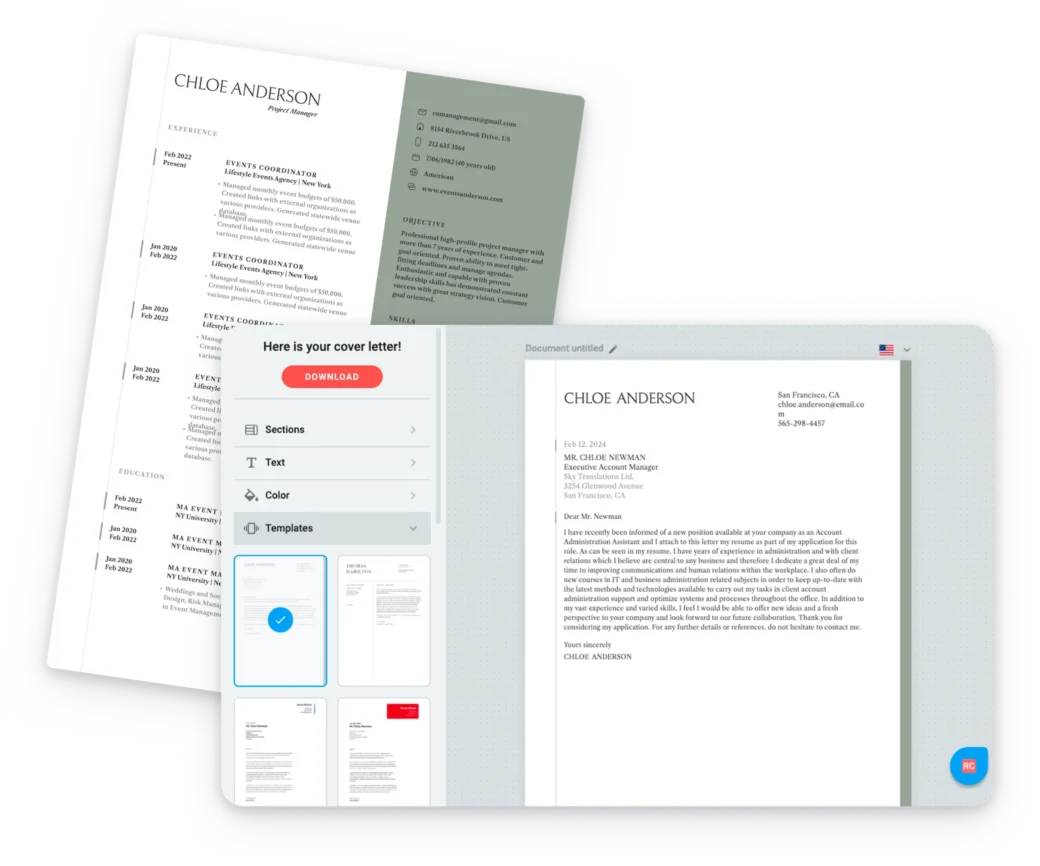
- Select one of our unique cover letter templates
- Write a text tailored to your professional profile
- Download your letter in PDF or TXT format and easily share it online
Have you ever heard of a motivation letter? It’s a powerful tool to help you snag that dream job and it’s becoming increasingly popular.
Let’s dive into what exactly a motivation letter is, when it’s best to use one, and how to write it. And don’t worry, we’ve got some inspiring examples to share with you too!
What Is a Motivation Letter?
So, what is a motivation letter , you ask? Well, it’s a short letter that explains why you’re the perfect fit for a job. We’re talking just one page here. It’s your chance to highlight your achievements and showcase your interests.
Typically, you’ll attach a motivation letter to your resume when you apply for a job. But that’s not all. You can use it in other situations, like applying to a college or university, an educational program, an internship, or even a volunteer role.
Now, you might be thinking, “Isn’t that what a cover letter is for?” Great question! There are indeed similarities and differences between these two documents. We’ll break it down for you in just a bit.

Motivation Letter vs. Cover Letter
Now, let’s talk about cover letters and motivation letters. They might seem pretty similar at first glance—both are 1 page or less and go along with your resume and application. Their goal? To impress the hiring manager and make them seriously consider your application.
But here’s the scoop: there’s one key difference between these two types of letters.
Cover letters dive into the nitty-gritty, with specific examples of how your education, skills, job experience, and achievements perfectly align with the job requirements. They concentrate on highlighting your work experience.
On the flip side, motivation letters take a broader approach . Instead of focusing on specifics, they showcase your interests, personality traits, and the reasons behind your application. They’re great when you don’t have much relevant experience to share. We’ll dig into this more in the next section.
See? Cover letters and motivation letters each have their own superpower. Let’s discover how to make the most of motivation letters for your dream job!
The best cover letter templates
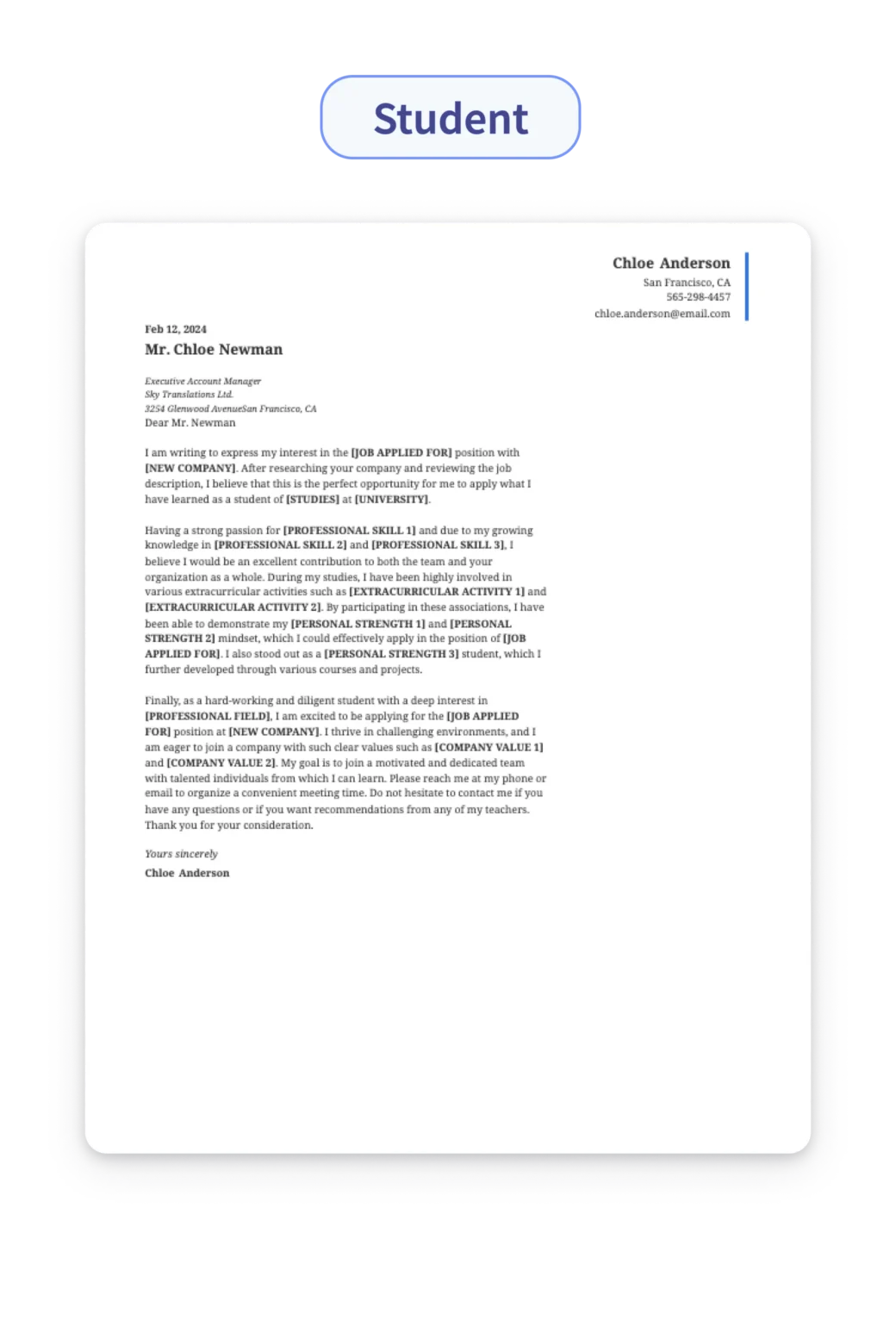
When to Use a Motivation Letter
As mentioned above, if you lack experience directly related to the position you want, a motivation letter can be a real game-changer. It’s perfect for those entry-level roles you’re aiming for.
1. Motivation Letter for University
Now, let’s dive into some specific situations. When it comes to applying to university, your application alone might not fully capture your passion and excitement. That’s where a motivation letter jumps in to save the day.
Use it as a platform to highlight your special connections with the university, why you’ve always dreamed of attending that specific school , or why you’d be an amazing fit for their programs. Show them the real you!
2. Motivation Letter for Job
And when it’s time to land your very first entry-level job , you might not have the work experience to boast about on your resume just yet. But don’t worry! Your enthusiasm and unique qualities can shine through in your motivation letter. It’s all about what makes you stand out from the crowd.
3. Other Times to Use Motivation Letters
Here’s something super cool: motivation letters aren’t limited to just education or employment. They can work their magic for other opportunities too. Just imagine the impact a motivational letter could have on your application for a volunteer position or an internship. It could be a total game-changer.

How to Format a Motivation Letter
The structure of a motivation letter is very important because it helps you present your ideas and showcase your desire to make a real impact in a new company.
In this section, we’ll dive into the key parts of a motivation letter: the introduction, body, and conclusion. But that’s not all! We’re also here to guide you on what to include in each section, so you can create a compelling, well-formed letter.
Introduction and Recipient Information
Starting your motivation letter with a professional salutation is the way to go. It shows that you mean business. Make sure to address the recipient by their name and title if you have that information. It adds a personal touch and shows that you’ve done your homework.
But if you don’t have the recipient’s name, don’t stress. You can use a general salutation like “Dear Sir/Madam” or “To Whom It May Concern.” It’s totally okay and still professional.
Next comes the introduction. It’s all about giving a brief introduction of yourself and stating the purpose of the letter. Are you applying for a job, internship, or scholarship? Let them know! Keep it concise and to the point.
Write a letter to tell why you want the job and what makes you good for it. Split the body into 2 or 3 paragraphs so it’s easy to read.
- Why you want the job : In the first part, tell why you want the job. Say what you like about the company and how the job fits your plans.
- What you can do : In the next part, talk about what you can do. Share things you’ve done before that show you’re right for the job. Use real examples to show your skills.
Finish your motivation letter layout by going over what you said and showing how excited you are about the job .
Let them know you’re ready to talk more and give them a way to contact you. Close your letter with words like “Sincerely” and then put your name.
A well-structured letter, with attention to detail, effectively presents your eagerness and qualifications for the position.

How to Write a Motivation Letter
If you find resume and cover letter writing, a challenge, you might feel that motivation letters are intimidating as well. The good news is, they don’t have to be!
Create a Motivation Letter Template
Now you know how a motivation letter should look. Let’s get into the details.
To know exactly how to write a motivation letter for a job application it’s really important to include all the necessary details. It should be like a regular business letter . Keep it professional and follow the usual format.
Use the steps below to show why you’re the best for the job.
- Use a template : A motivation letter template can help you write better and not miss anything.
- Your address : Put your address at the top or just above the date. Only add your street, city, state, and zip. No need for your name here.
- Date : Write the full date, like “April 6, 2023.”
- Who you’re writing to : Write the person’s title, name, and address. Make sure it’s all correct.
- Greeting : Start with “Dear” and the person’s name or title, like “Dear Mr. Smith.” Use a colon after.
- What to say : Split your letter into short parts. Start by stating the position or program you are interested in, then explain your motivations. Highlight your qualifications, skills, and relevant experiences that make you an ideal candidate. Be specific and provide examples or anecdotes that support your claims.
- End your letter : Finish with words like “Sincerely” or “Thank you.” This shows you’re thankful for their time.
- Sign it : If it’s a paper letter, leave space to sign your name. If it’s an email, you don’t need this space.
Always type your full name on the letter, whether it’s on paper or email. This shows it’s really from you and you agree with what’s written.
If you send other documents with your letter, like a resume, say so in the letter. Write something like “Enclosures: Resume, Application.”
In emails, just say you’ve added attachments below your name or in the letter.
Motivation Letter Writing Tips
You can use the following tips as a checklist to make sure your letter is the best it can be.
- Use the hiring manager’s name : If you don’t know it, look on the company’s website or call them. If you’re not sure about their gender, just use their job title or full name without “Mr.” or “Dr.”
- Don’t just repeat your resume in the letter : Instead, add the things that didn’t fit in your resume.
- Use action verbs : to make your letter lively.
- Include resume keywords . The company might pass both your resume and letter through an applicant tracking system (ATS).
- Don’t sound too eager or make things up : They’ll find out if you’re not honest.
- At the end, include why you’re right for the job and what you hope to learn. Last, ask them to contact you or say you hope to talk soon.
- Check your letter for mistakes : Use tools like Grammarly to help.
Enhance your content with our pre-defined cover letters
Do you need help writing your cover letter? Select the category that corresponds to your professional profile to access our pre-defined texts.
Our suggestions enable you to obtain a compelling letter tailored to your profession quickly and easily.
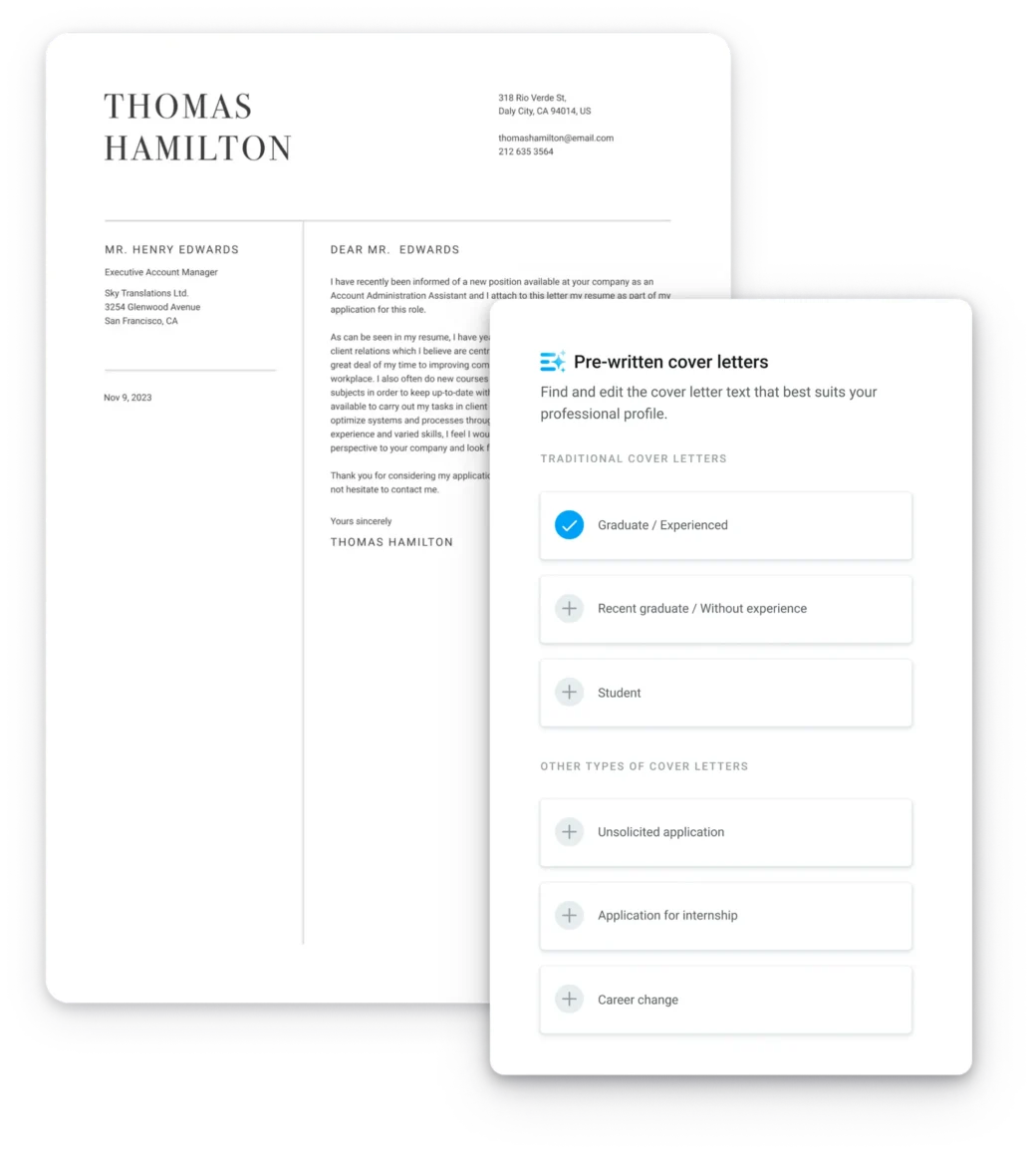
Motivation Letter Sample
Motivation letters are used for many reasons, so they can vary significantly. You can change the example in this section to fit your needs.
The motivation letter example below is about an entry-level job for Raul. He hasn’t held a paying job before, but he highlights experiences that might not be on his resume.
123 Address Street
Anywhere, USA 33333
September 10, 2022
ABC Company
456 Workplace Lane
Dear Mr. Smith:
As a first-generation university student, I am looking for a position that will enable me to pay my tuition while making allowances for my class schedule. When I saw your job listing for a weekend Customer Service Representative on the campus information board, I felt that we would be a perfect fit for each other’s needs.
While my on-the-job experience is limited, I have a great deal of experience in dealing with customers. Throughout my teenage years, I have helped out in the family business, a small convenience and souvenir store at the heart of a tourist district.
My duties there were often public-facing, arranging items for sale and assisting customers in finding what they needed. I always did my best to help customers leave with smiles on their faces, even going above and beyond what might be expected. This resulted in many 5-star reviews for the business on Tripadvisor and Google.
Thank you for your consideration. I’d be happy to speak with you in person or via phone to discuss the position and my qualifications further.
With gratitude:
Raul Ascencio
The following motivation letter example concerns an academic program. Sue is a high school senior seeking a summer internship after graduation. Her letter is imbued with a passion for the field as well as its relationship to her career goals.
March 1, 2023
Cindy Diver
Caribbean Coral Restoration Project
789 Coastal Road
Nassau, Bahamas
Dear Dr. Diver,
For as long as I can remember, I’ve wanted to do something to help reverse the damage humans have caused to our planet. For that reason, I was thrilled to receive an invitation to apply to the Caribbean Coral Restoration Project summer program.
Though I come from a landlocked state, I received my open water scuba certification from SDI last August. Training took place in a flooded quarry in Pembroke, Kentucky. I look forward to taking my first “real” oceanic open water dive in the warm waters near your research station.
During my high school education, I have pursued as many ecological opportunities as possible. I participated in the 4-H Club’s Wildlife Judging Team for four years, twice winning regional competitions. I also keep an action camera as a constant companion, participating in citizen science projects such as iNaturalist and Cornell University’s annual bird count.
I have been accepted into State University’s biology program, beginning next fall. After obtaining a bachelor’s degree in biology, I plan to pursue my master’s in marine biology. I hope to start that part of my journey with real field experience under my belt. Please feel free to contact me if you require any further information. My application and resume are enclosed.
Key Takeaways
With the correct format and style, you can create a motivation letter that can win over any recruiter. To do so remember the key points that were addressed in this guide.
- Motivation letters can effectively be used in place of cover letters when you have little experience or are applying to a university, internship, or volunteer program.
- Use professional business letter formats.
- Address your motivations and qualifications clearly in the body of your letter.
- Express your personality, passions, and motivations.
Ensuring your letter is written in this style will boost your chances whether you’re an entry-level employee or an experienced worker.
Discover the additional features of our online editor
- Editor available in 13 languages
- Create s everal resumes and cover letters
- Secure permanent storage
- Usable on a variety of devices
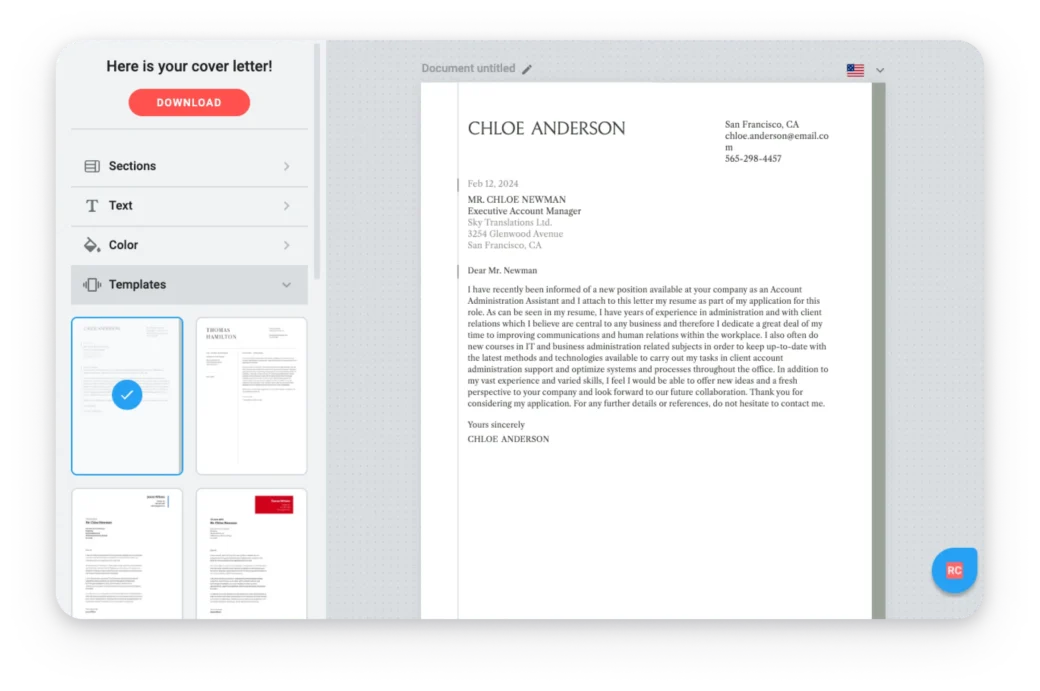
Related Posts

Trouble getting your Cover Letter started?
Beat the blank page with expert help.
- All Articles
- Paycheck Calculator
- POPULAR POSITIONS

- Whitepapers
Get the latest insights in the restaurant industry
Oysterlink Spotlight Interview Guides

How To Write a Motivation Letter + 4 Examples

When applying for a job, you want to show more than just knowledge and an abundance of skills to your future employers. You need to add a personal touch and the best way to do it is a well-written and engaging motivation letter.
But, what is a motivation letter? Is it the same as a cover letter? How to write one? We’ll address these questions and provide four examples you can use to present yourself in the best light.
Table of Contents
What is a Motivation Letter?
A motivation letter, also called a motivational letter, is a succinct one-page document that outlines why you are the ideal candidate for a particular role, such as a job, educational program, internship or volunteer opportunity.
You’ll typically attach this letter to your CV when applying for various jobs or other opportunities.
It serves as a personal statement of your motivations and intentions. The focus is on showcasing your enthusiasm and commitment beyond what’s listed on your resume.
It is an opportunity to emphasize the personal elements that make you a standout candidate.
Motivation Letter vs. Cover Letter
While both motivation letters and cover letters serve the purpose of introducing yourself in a job application, there are some key differences between the two:
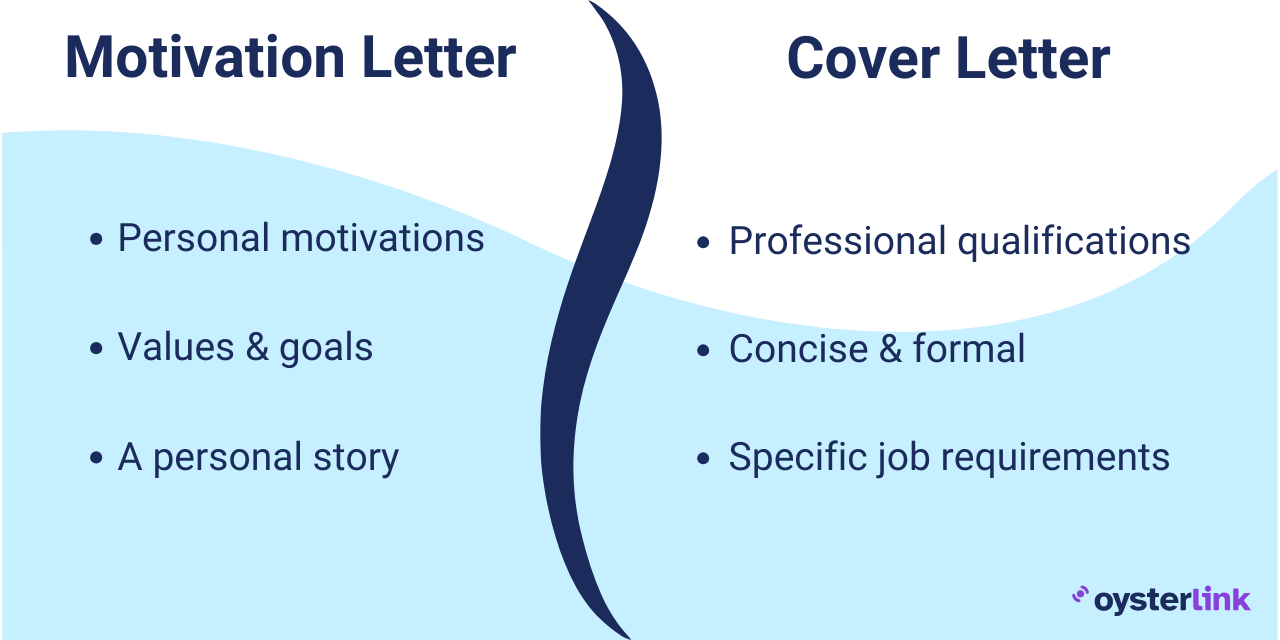
Motivation Letter:
- Focus on personal motivations
- Explores values and goals
- Provides a personal story
Cover Letter:
- Highlights professional qualifications
- Concise and formal
- Addresses specific job requirements
How to Write a Motivational Letter
Writing motivational letters that leave a positive impression should be well structured. This involves knowing what to include and what not to include in it.
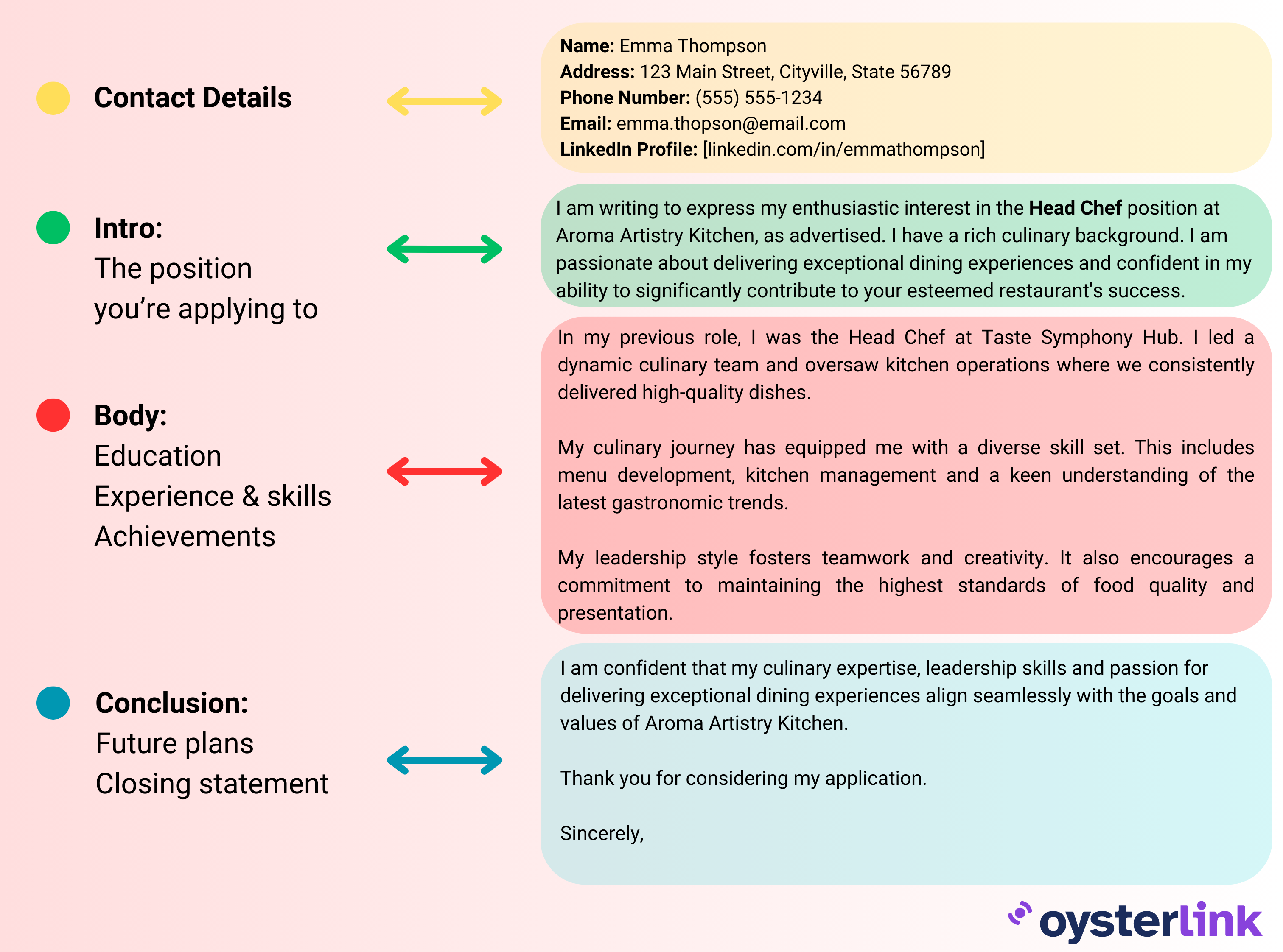
Let’s break down this process to reveal its essential elements:
- Contact details
Introduction
1. contact details.
In this section, you will want to include the following information:
- Academic degree (if applicable)
- Telephone number
- Email address
- Links to relevant social accounts such as your LinkedIn profile
2. Introduction
Begin with a professional greeting and clearly state the purpose of your letter.
It’s best if you know the exact contact person/hiring manager you are talking to and address them by their name right from the start. This shows you’ve done your research and helps you establish a more personalized connection.
In essence, your introduction should answer the following questions:
- What position are you applying for?
- What fuels your interest in joining the team for this job?
- What are you bringing to the organization (your skills and qualities)?
- Why are you the right person for the job?
Use clear, concise language and focus on essential details only.
The body of motivation letters is an extension of your introduction. It usually consists of two or three paragraphs.
The paragraphs convey your enthusiasm for the job and highlight your qualifications.
Why you want the job:
- Express your genuine interest in the position and the company
- Highlight specific aspects you like about the company, such as its values, mission or work culture
- Explain how the job aligns with your career goals and plans
What you can do:
- Showcase your skills and qualifications relevant to the job
- Provide real-life examples of past experiences and achievements
- Use metrics or specific details to add credibility to your statements
Passion and value proposition:
- Convey your passion for the role and the industry
- Discuss how your unique qualities and values align with the company’s mission
- Reinforce your commitment to contributing to the success and growth of the company
Remember to be concise, factual and persuasive. Use clear examples to illustrate your points and show why you are the perfect candidate for the job.
4. Conclusion
In the conclusion of your motivation letter, you want to summarize your key points. This is where you voice your gratitude and leave a positive final impression.
Include the following:
- Briefly recap why you are excited about the job and how it aligns with your career goals
- Thank the reader for considering your application
- Express appreciation for the chance to be part of the selection process
- Reaffirm your excitement about the opportunity and the prospect of contributing to the company’s success
- Politely invite the reader to contact you for further discussion or clarification
- Use a formal closing salutation such as “Sincerely” or “Best Regards”
- Sign off with your full name
Remember to keep this section brief and positive, leaving the reader with a favorable impression of your candidacy.
What Not to Include in Your Motivational Letter
When writing a motivation letter, there are common mistakes you should avoid.
Try to resist the urge to emphasize your weaknesses. While honesty is a valuable trait to have, the motivation letter is the opportunity to showcase your strengths.
Keep your language straightforward and concise. Avoid using fluff words or overly elaborate sentences.
Keep away from statements like “I feel extremely passionate.” Instead, mention a specific event or project you have been a part of. This showcases the genuine depth of your enthusiasm for a subject or field.
Apply the “ So what? ” rule. Ask yourself, ‘ So what does this add to my candidacy?’ If the information doesn’t directly strengthen your case or highlight relevant skills, consider excluding it.
What is the Best Format of a Motivational Letter?
The best motivation letter is formatted in a professional manner. It should be well-organized and tailored to the specific job or program.
Here is a recommended motivation letter template you should follow:
The header is reserved for your personal info, including:
- Your Address (Street, City, State, Zip Code)
- Email Address
- Phone Number
- Links to your relevant social accounts
Don’t forget to include the correct date following the Month-Day-Year US format :
- “January 15, 2024”
Recipient’s Information
Include the recipient’s relevant information, such as:
- Recipient’s Name
- Recipient’s Title (if applicable)
- Company Name (if applicable)
Start with a formal greeting, such as:
- “Dear [Mr./Ms.] [Last Name],” “Esteemed [Mr./Ms.] [Last Name],”
Here’s what you should write in your motivation letter intro:
- The position or program you are applying for
- A brief expression of your enthusiasm for the opportunity
In the body part of your motivation letter, include the following:
- Explain why you are interested in the position or program.
- Emphasize your genuine passion and connection.
- Highlight relevant skills, experiences and achievements.
- Show how your values and goals align with those of the company or program.
The conclusion is where you should briefly summarize the whole purpose of your motivation letter. Here’s what to do:
- Summarize your main points
- Express gratitude for the opportunity
- Use a closing phrase such as “Sincerely” or “Thank you”
- Sign your full name at the bottom
It is also important how your motivation letter looks at first glance. So, pay attention to the following features:
- Consistency: Maintain a consistent font and formatting throughout the letter
- Length: Keep it concise, ideally one page
- Structure: Divide the text into smaller blocks for better readability
4 Motivation Letter Examples
We will provide four examples to guide you through your application process. This will help you look at the motivation letter as a full picture.
1. An Example of a Motivation Letter for a University
Let’s say you need to write a motivation letter to apply for the University of Environmental Science, EcoSphere.
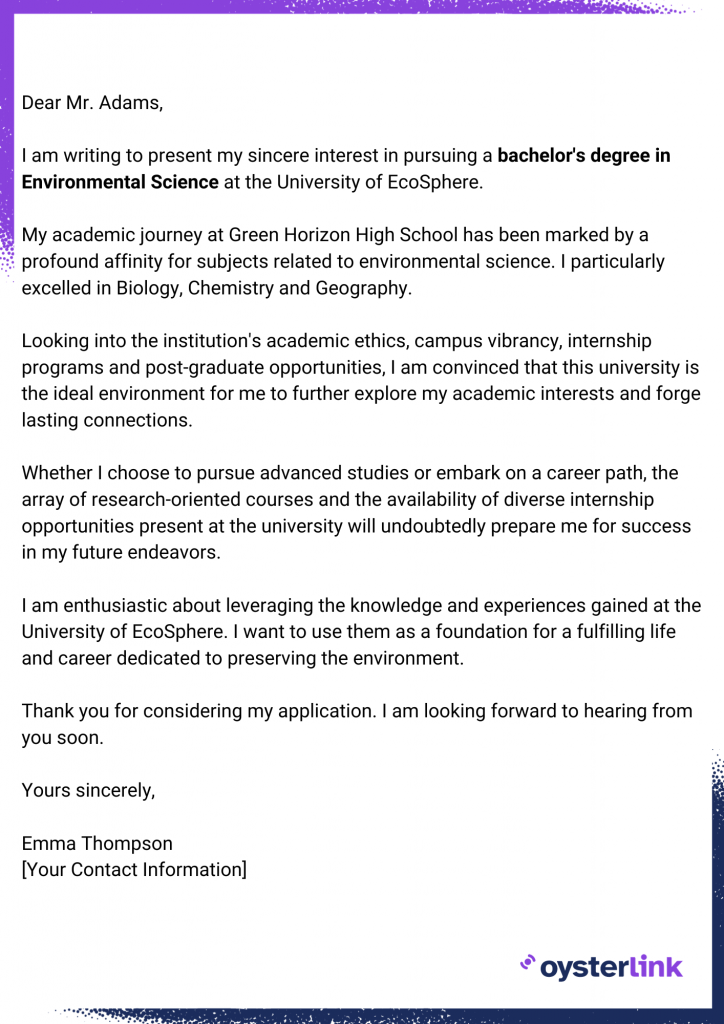
2. An Example of a Motivation Letter for a Scholarship
A motivation letter example when applying for a scholarship should look similar to this.
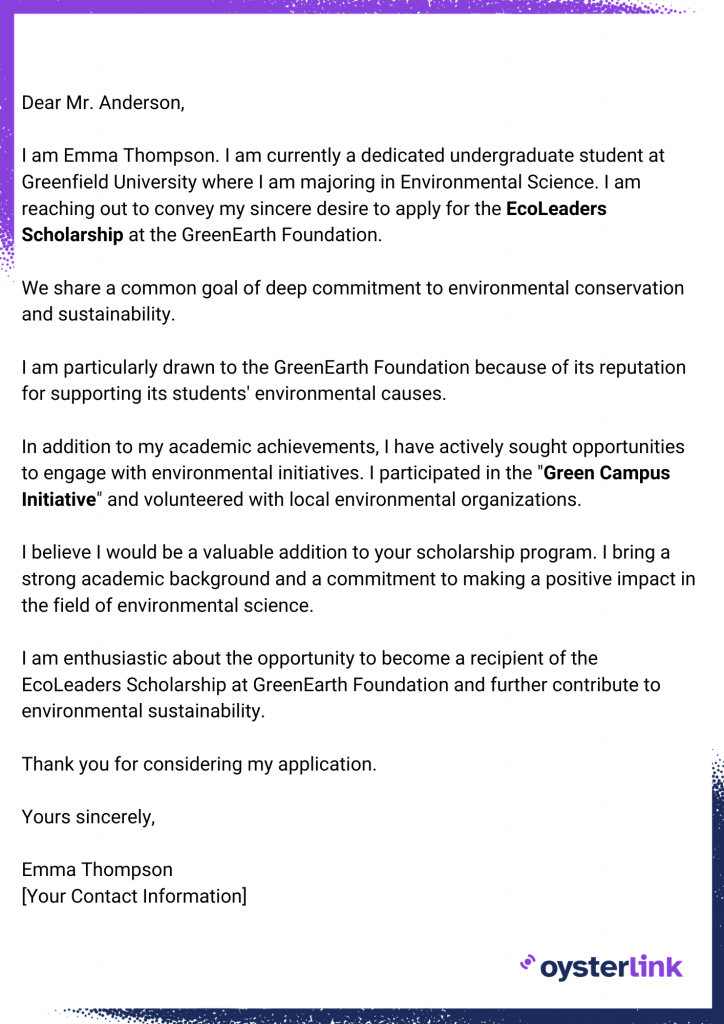
3. An Example of a Motivation Letter for an Internship
If applying for an internship, follow this sample motivation letter structure.
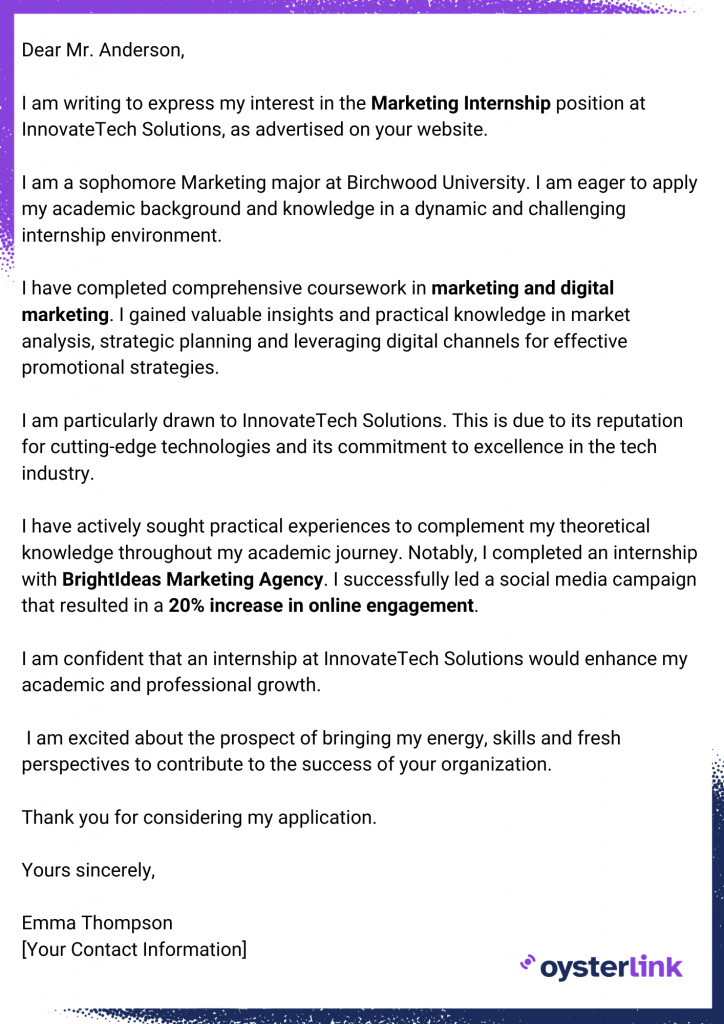
4. An Example of a Motivation Letter for a Job Application
Here is an example of a motivation letter you can use as a guide when applying for a, let’s say, restaurant job .
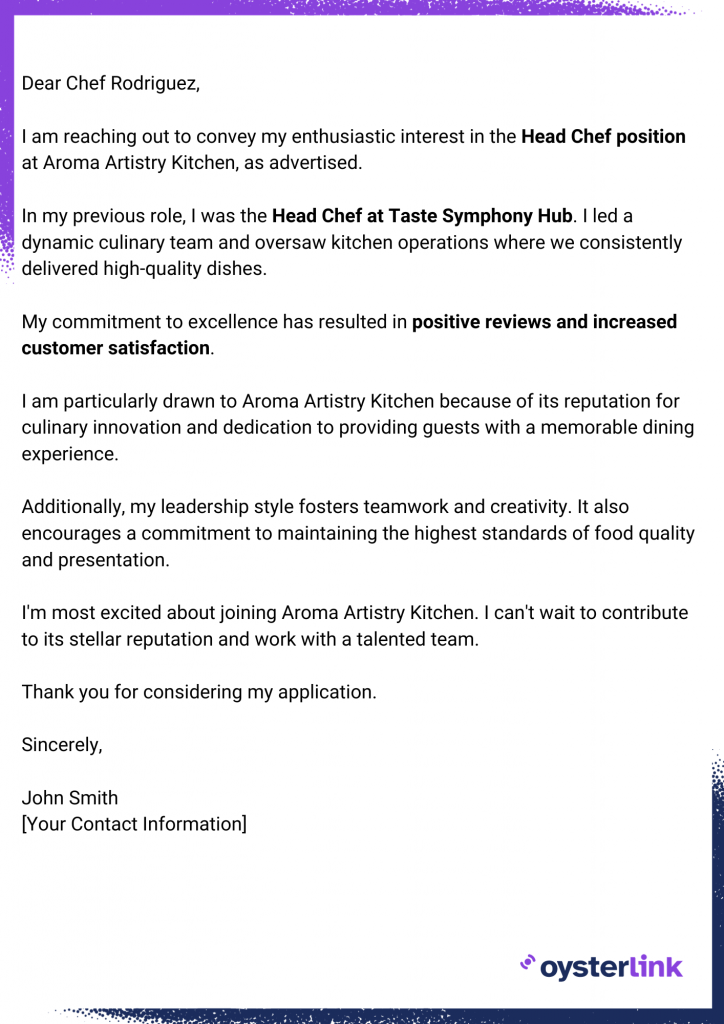
Key Takeaways
When you write a motivation letter, consider its purpose: revealing your personality and traits. Structure your motivation letters so they include your contact details, an introduction a body and a conclusion.
In the contact details section, provide essential information. Include your name, academic degree, address, phone number, email, and relevant social links. Start the introduction with a professional greeting. State your purpose and answer key questions briefly.
The body is an extension of your introduction. Your cover letter should consist of paragraphs expressing your genuine interest in the job. Showcase your skills and convey your passion and unique value proposition. Be concise, factual and persuasive.
Conclude your motivation letters by summarizing key points. Express gratitude and leave a positive final impression. Avoid emphasizing weaknesses, use straightforward language, and be specific about your passion.
For the format, ensure it is professional, well-organized and tailored to the specific job or academic program you’re applying for.
Keep the letter concise, ideally one page and maintain a consistent font and formatting throughout.
Frequently Asked Questions
Here are the answers to some of the most frequently asked questions about writing a motivation letter.
What is the primary purpose of a motivational letter.
The motivational letter serves as a personalized narrative, allowing you to articulate not only your professional qualifications but also the underlying motivations and passions that drive your interest in a particular opportunity.
It goes beyond a traditional resume by providing insight into your character, values and unique attributes.
This document showcases not just what you can do, but also why you are genuinely enthusiastic and well-suited for the specific role, academic program or scholarship you are applying for.
How to structure the introduction of the motivation letters?
When structuring the introduction of your motivational letter, commence with a formal and professional salutation, addressing the recipient appropriately.
Following this, concisely articulate the primary purpose of your letter, explicitly stating why you are reaching out.
It is crucial to immediately establish clarity by offering succinct responses to fundamental questions, such as specifying the position, program or opportunity you are applying for.
Next, state your motivation for applying and briefly outline the unique qualities and qualifications that make you a suitable candidate.
What information should be covered in the body of the motivation letters?
In the body of the motivation letter, provide the specifics of your application by expressing authentic enthusiasm for the opportunity. Communicate your genuine interest by highlighting aspects of the job, academic program or scholarship that resonate with your career goals or academic pursuits.
Substantiate your claims by showcasing concrete examples of your skills and qualifications, providing tangible evidence of your capabilities. Emphasize not only what you can do but also how your unique background, experiences and perspective contribute to your value proposition.
This section serves as the core of your letter, painting a comprehensive picture of why you are the ideal candidate or scholar for the position or program in question.
How long should a motivation letter be?
A good motivation letter should typically be concise, and ideally limited to one page. Keeping it succinct ensures that the reader can quickly grasp the key points without being overwhelmed by excessive information.
Is the motivation letter the same as the cover letter?
No. A cover letter is a formal document submitted alongside a resume or CV during a job application. It serves as an introduction to the applicant and complements the details provided in the resume.
The cover letter typically includes information about the applicant’s qualifications, skills and experiences relevant to the job. In contrast, a motivation letter is often used in academic or international contexts.
It delves into personal motivations, passions, and goals related to the opportunity.
How can you effectively address a surface-level experience in your motivation letter?
In your motivation letter, consider highlighting your enthusiasm for learning. Include your transferable skills and relevant qualities. They make you a strong candidate despite limited formal experience.
Emphasize your eagerness to contribute and willingness to undergo training. Also, mention any related achievements or experiences that showcase your potential and dedication.
How to conclude your motivational letter effectively?
In conclusion, summarize key qualifications and motivations to reinforce your candidacy. Express gratitude for the opportunity, and reaffirm your excitement about contributing.
Conclude with a formal closing salutation, such as “ Sincerely ” or “ Best Regards ,” followed by your full name, maintaining professionalism and leaving a positive and open-ended impression.
You May Also Like

How To Write a Cover Letter + 3 Examples

How To Negotiate Salary After a Job Offer

Best Excuses To Get Out of Work + Fake Excuses To Avoid

Easy Jobs That Pay Well in the Restaurant Industry

How To Keep More of Your Paycheck

Restaurant Worker Trends: Seizing Market Opportunities
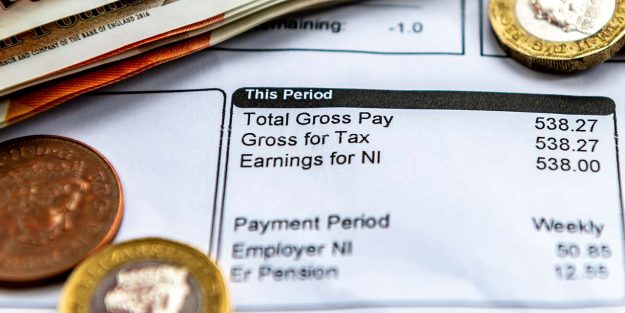
What Is a Pay Stub and What Information Does It Hold?

Writing an excellent cover letter: What is a cover letter?
A cover letter is an introductory letter addressed to a hiring manager in response to an advertised job by the hiring company. Typically, a job applicant writes the cover letter elaborating the skills, abilities, experiences, and other factors that would make him or her appropriate for a particular job. Most companies demand a resume be submitted with an application letter to expound on the applicant’s reasons for applying for the position. The main purpose of a cover letter is to express the reasons for applying for an available vacancy for the job. While many people overlook the importance of this document, it plays a primary role in convincing the employer to read the CV keenly and consider the applicant for the job. This is why applicants should strive to write a cover letter that sells their expertise.
A cover letter example - the required format
Here is an example of a cover letter that would be effective in convincing an employer:
Dear Sir/Madam,
I write to convey my interest in the position of a psychologist in your company, which was advertised through the print media. The description in the advertisement matches my skills, abilities, talents, and training. I have worked in a similar position at an international company, and I demonstrated proper professionalism and competence. My experience in working with children and youths as a psychologist qualifies me for this position. If all you need is a competent psychologist who will make noticeable changes in your organization, then I am the right person for the job.
What is a letter of motivation, and when is it used?
A letter of interest is an introductory letter addressed to an organization that may not necessarily have a job available for the applicant. Writing a letter of interest communicates one’s desire to work with the target company if a chance arises. The synonym for this document is a letter of inquiry, which is composed with an intention to seek for opportunities of an internship, admission to a school or college, a volunteer position in an organization and so on. The applicant can write a letter of interest while in school or other duties. Unlike a cover letter, which is written in response to an available position, a letter of motivation only inquires if there is a job and expresses a desire to work with the company in future. Often, the organization should be related to the training of the applicant.

A motivation letter example that applicants can use
I would like to work with your company as an intern in web design starting January 2019. I am a student of computer science pursuing my degree at the University of Pretoria. My area of interest is web design and coding. I have exceptional skills and abilities in designing websites. Since your company deals with web design, I express my desire to join you in completing my coursework. I would also want to know if you have a web designer or if you would consider such a post in your organization in future. I would be glad to serve in such a position and use my skills to make a difference in your company.
Motivation letter vs cover letter: When to use each of them
The difference between a letter of interest and a cover letter ranges from their definition, their use, and contents. They are essential writings that could warrant a job seeker an opportunity to work with the desired organization. The major difference between a cover letter and a letter of interest is that the latter seeks to inquire about a possible position and express interest for the future. However, the former is a responsive writing to an available position. A perfect cover letter gives a clear demonstration of the job requirements of a specific company or employer. However, the letter of interest can be written any time irrespective of the availability of a job.
Writing effective applications
With the various types of application documents available, it is good to master the content of each one of them. It will not only secure your position and but reveal your professionalism and seriousness with work. Some of the application documents everyone should know how to writer entails:
- Cover letter
- Application letter
- Curriculum Vitae
- Letter of interest
- Personal statement
You could be wondering how to write a proper application document. Worry not: you can get the best cover builder from our platform to help you.
Lorem ipsum dolor sit amet, consectetur adipisicing elit. Alias aut delectus magni officia quidem quis tempora veniam. Culpa eius expedita mollitia nemo perspiciatis. Atque ipsum quas quis repellat voluptate. Placeat?
How to Write a Cover Letter in 2024 + Examples

After weeks of heavy job search, you’re almost there!
You’ve perfected your resume.
You’ve short-listed the coolest jobs you want to apply for.
You’ve even had a friend train you for every single interview question out there.
But then, before you can send your application and call it a day, you remember that the job ad requires a cover letter.
Now you’re stuck wondering how to write a cover letter ...
Don’t panic! We’ve got you covered. Writing a cover letter is a lot simpler than you might think.
In this guide, we’re going to teach you how to write a cover letter that gets you the job you deserve.
- What’s a cover letter & why it’s important for your job search
- How to write a convincing cover letter that gets you the job (step-by-step!)
- How to perfect your cover letter with the Novoresume free checklist
- What excellent cover letter examples look like
New to cover letter writing? Give our resumes 101 video a watch before diving into the article!
So, let’s get started with the basics!
What is a Cover Letter? (and Why It’s Important)
A cover letter is a one-page document that you submit as part of your job application (alongside your CV or Resume).
Its purpose is to introduce you and briefly summarize your professional background. On average, your cover letter should be from 250 to 400 words long .
A good cover letter can spark the HR manager’s interest and get them to read your resume.
A bad cover letter, on the other hand, might mean that your application is going directly to the paper shredder. So, to make sure this doesn’t happen, it’s essential to know how to write a convincing cover letter.
How does a good cover letter look, you might ask. Well, here’s an example:

Keep in mind, though, that a cover letter is a supplement to your resume, not a replacement. Meaning, you don’t just repeat whatever is mentioned in your resume.
If you’re writing a cover letter for the first time, writing all this might seem pretty tough. After all, you’re probably not a professional writer.
The thing is, though, you don’t need to be creative, or even any good at writing. All you have to do is follow a tried-and-tested format:
- Header - Input contact information
- Greeting the hiring manager
- Opening paragraph - Grab the reader’s attention with 2-3 of your top achievements
- Second paragraph - Explain why you’re the perfect candidate for the job
- Third paragraph - Explain why you’re a good match for the company
- Formal closing
Or, here’s what this looks like in practice:

How to Write the Perfect Cover Letter (And Get Hired!)
Now that we’ve got the basics out of the way, we’re going to guide you through the process of writing a cover letter step by step.
Step #1 - Pick the Right Cover Letter Template
A good cover letter is all about leaving the right first impression.
So, what’s a better way to leave a good impression than a well-formatted, visual template?

You can simply pick one of our hand-picked cover letter templates , and you’ll be all set in a jiffy!
As a bonus, our AI will even give you suggestions on how to improve your cover letter on the go.
Step #2 - Start the Cover Letter with a Header
As with a resume, it’s important to start your cover letter with a Contact Information section:

Here, you want to include all essential information, including:
- Phone Number
- Name of the hiring manager / their professional title
- Name of the company you’re applying to
In certain cases, you might also consider adding:
- Social Media Profiles - Any type of profile that’s relevant to your field. Social Profiles on websites like LinkedIn, GitHub (for developers), Medium (for writers), etc.
- Personal Website - If you have a personal website that somehow adds value to your application, you can mention it. Let’s say you’re a professional writer. In that case, you’d want to link to your blog.
And here’s what you shouldn’t mention in your header:
- Your Full Address
- Unprofessional Email - Make sure your email is presentable. It’s pretty hard for a hiring manager to take you seriously if your email address is “[email protected].” Whenever applying for jobs, stick to the “[first name] + [last name] @ email provider.com” format.

Step #3 - Greet the Hiring Manager
Once you’ve properly listed your contact information, you need to start writing the cover letter contents.
The first thing to do here is to address the cover letter to the hiring manager .
That’s right, the hiring manager! Not the overly popular “Dear Sir or Madam.” You want to show your future boss that you did your research and are really passionate about working with their team.
No one wants to hire a job seeker who just spams 20+ companies and hopes to get hired in any of them.
So, how do you find out who’s the hiring manager? There are several ways to do this.
The simplest option is to look up the head of the relevant department on LinkedIn. Let’s say you’re applying for the position of a Communication Specialist at Novoresume. The hiring manager is probably Head of Communications or Chief Communications Office.
So, you do a quick lookup on LinkedIn:

And voila! You have your hiring manager.
Or let’s say you’re applying for the position of a server. In that case, you’d be looking for the “restaurant manager.”
If this doesn’t work, you can also check out the “Team” page on the company website; there’s a good chance you’ll at least find the right person there.
Here are several other greetings you could use:
- Dear [Department] Hiring Manager
- Dear Hiring Manager
- To whom it may concern
- Dear [Department] Team
Step #4 - Write an Attention-Grabbing Introduction
First impressions matter, especially when it comes to your job search.
Recruiters get hundreds, sometimes even thousands, of applications. Chances are, they’re not going to be reading every single cover letter end-to-end.
So, it’s essential to catch their attention from the very first paragraph .
The #1 problem we see with most cover letter opening paragraphs is that they’re usually extremely generic. Most of them look something like this..
- Hey, my name is Jonathan and I’d like to work as a Sales Manager at XYZ Inc. I’ve worked as a sales manager at MadeUpCompany Inc. for 5+ years, so I believe that I’d be a good fit for the position.
See the issue here? This opening paragraph doesn’t say pretty much anything except the fact that you’ve worked the job before.
Do you know who else has similar work experience? All the other applicants you’re competing with.
Instead, you want to start off with 2-3 of your top achievements to really grab the reader’s attention. Preferably, the achievements should be as relevant as possible to the position.
So now, let’s make our previous example shine:
My name’s Michael and I’d like to help XYZ Inc. hit and exceed their sales goals as a Sales Manager. I’ve worked with Company X, a fin-tech company, for 3+ years. As a Sales Representative, I generated an average of $30,000+ in sales per month (beating the KPIs by around 40%). I believe that my previous industry experience, as well as excellence in sales, makes me the right candidate for the job.
See the difference between the two examples? If you were the hiring manager, which sales manager would you hire, Jonathan or Michael?
Now that we’ve covered the introduction, let’s talk about the body of your cover letter. This part is split into two paragraphs: the first is for explaining why you’re the perfect person for the job, and the latter is for proving that you’re a good fit for the company.
So, let’s get started...
Step #5 - Explain why you’re the perfect person for the job
This is where you show off your professional skills and convince the HR manager that you’re a better fit for the job than all the other applicants.
But first things first - before you even write anything, you need to learn what the most important requirements for the role are. So, open up the job ad and identify which of the responsibilities are the most critical.
For the sake of the example, let’s say you’re applying for the position of a Facebook Advertiser. You scan the job ad and see that the top requirements are:
- Experience managing a Facebook ad budget of $10,000+ / month
- Some skills in advertising on other platforms (Google Search + Twitter)
- Excellent copywriting skills
Now, in this section, you need to discuss how you fulfill these requirements. So, here’s how that would look for our example:
In my previous role as a Facebook Marketing Expert at XYZ Inc. I handled customer acquisition through ads, managing a monthly Facebook ad budget of $20,000+ . As the sole digital marketer at the company, I managed the ad creation & management process end-to-end. Meaning, I created the ad copy , images, picked the targeting, ran optimization trials, and so on.
Other than Facebook advertising, I’ve also delved into other online PPC channels, including:
- Google Search
Are you a student applying for your first internship? You probably don’t have a lot of work experience to show off in this section. Learn how to write an internship cover letter here.
Step #6 - Explain why you’re a good fit for the company
Once you’ve written the last paragraph, you might be thinking - I’m a shoo-in for the job! What else do I need to write? I’ll just wrap up the cover letter and hit that sweet SEND button.
Well, no. You’re not quite there yet.
The HR manager doesn’t only look at whether you’ll be good at the job or not. They’re looking for someone that’s also a good fit for the company culture.
After all, employees that don’t fit in are bound to quit, sooner or later. This ends up costing the company a ton of money, up to 50% of the employee’s annual salary .
Meaning, you also need to convince the HR manager that you’re really passionate about working with them.
How do you do this? Well, as a start, you want to do some research about the company. You want to know things like:
- What’s the company’s business model?
- What’s the company product or service? Have you used it?
- What’s the culture like? Will someone micro-manage your work, or will you have autonomy on how you get things done?
So, get to Googling. Chances are, you’ll find all the information you need either on the company website or somewhere around the web.
Then, you need to figure out what you like about the company and turn that into text.
Let’s say, for example, you’re passionate about their product and you like the culture of innovation / independent work in the organization.
You’d write something like:
I’ve personally used the XYZ Smartphone, and I believe that it’s the most innovative tech I’ve used in years. The features such as Made-Up-Feature #1 and Made-Up-Feature #2 were real game changers for the device.
I really admire how Company XYZ thrives for excellence for all its product lines, creating market-leading tech. As someone that thrives in a self-driven environment, I truly believe that I and Company XYZ will be a great match.
What you don’t want to do here is be super generic for the sake of having something to write. Most job seekers tend to mess this one up. Let’s take a look at a very common example we tend to see (way too often):
I’d love to work for Company XYZ because of its culture of innovation. I believe that since I’m super creative, I’d be a good fit for the company. The company values of integrity and transparency really vibe with me.
See what’s wrong here? The example doesn’t really say anything about the company. “Culture of Innovation” is something most companies claim to have.
The same goes for “values of integrity and transparency” - the writer just googled what the values for the organization are, and said that they like them.
Any hiring manager that reads this will see through the fluff.
So, make sure to do a lot of research and come up with good reasons why you're applying.
Step #7 - Wrap up with a call to action
Finally, it’s time to finish up your cover letter and write the conclusion.
In the final paragraph, you want to:
- Wrap up any points you couldn't in the previous paragraphs. Do you have anything left to say? Any other information that could help the hiring manager make their decision? Mention it here.
- Thank the hiring manager for their time. It never hurts to be courteous, as long as you don’t come off as too needy.
- Finish the cover letter with a call to action. The very last sentence in your cover letter should be a call to action. You should ask the hiring manager to take some sort of action.
And now, let’s turn this into a practical example:
So to wrap it all up, thanks for looking into my application. I hope I can help Company X make the most out of their Facebook marketing initiatives. I'd love to further discuss how my previous success at XYZ Inc. can help you achieve your facebook marketing goals.
Step #8 - Use the right formal closing
Once you’re done with the final paragraph, all you have to do is write down a formal “goodbye” and you’re good to go.
Feel free to use one of the most popular conclusions to a cover letter:
- Best Regards,
- Kind Regards,
And we’re finally done! Before sending off the cover letter, make sure to proofread it with software like Grammarly, or maybe even get a friend to review it for you.
Does your cover letter heading include all essential information?
- Professional email
- Relevant Social Media Profiles
Do you address the right person? I.e. hiring manager in the company / your future direct supervisor
Does your introductory paragraph grab the reader's attention?
- Did you mention 2-3 of your top achievements?
- Did you use numbers and facts to back up your experience?
Do you successfully convey that you’re the right pro for the job?
- Did you identify the core requirements?
- Did you successfully convey how your experiences help you fit the requirements perfectly?
Do you convince the hiring manager that you’re passionate about the company you’re applying to?
- Did you identify the top 3 things that you like about the company?
- Did you avoid generic reasons for explaining your interest in the company?
Did you finalize the conclusion with a call to action?
Did you use the right formal closure for the cover letter?
5+ Cover Letter Examples
Need some inspiration? Read on to learn about some of the best cover letter examples we’ve seen (for different fields).
College Student Cover Letter Example

Middle Management Cover Letter Example

Career Change Cover Letter Example

Management Cover Letter Example

Senior Executive Cover Letter Example

Want to discover more examples AND learn what makes them stand out? Check out our guide to cover letter examples .
Next Steps in Your Job Search - Creating a Killer Resume
Your cover letter is only as good as your resume. If either one is weak, your entire application is for naught.
After all, a cover letter is just an introduction. Imagine going through all this effort to leave an amazing first impression, but flopping at the end because of a mediocre resume.
...But don’t you worry, we’ve got you covered on that end, too.
If you want to learn more about Resumes & CVs, we have a dedicated FREE guide for that. Check out our complete guide on how to make a resume , as well as how to write a CV - our experts will teach you everything you need to know in order to land your dream job.
Or, if you’re already an expert, just pick one of our resume templates and get started.

Key Takeaways
Now that we’ve walked you through all the steps of writing a cover letter, let’s summarize everything we’ve learned:
- A cover letter is a 250 - 400 word document that convinces the hiring manager of your competence
- A cover letter goes in your job application alongside your resume
- Your introduction to the cover letter should grab the hiring manager’s attention and keep it all the way until the conclusion
- There are 2 main topics you need to include in your cover letter: why you’re the perfect candidate for the job & why you’re passionate about working in the company you’re applying to
- Most of the content of your cover letter should be factual , without any fluff or generalizations
At Novorésumé, we’re committed to helping you get the job you deserve, every step of the way! Follow our blog to stay up to date with the industry-leading advice. Or, check out some of our top guides…
- How to Write a Motivational Letter
- How to Write a Resume with No Work Experience
- Most Common Interview Questions and Answers

To provide a safer experience, the best content and great communication, we use cookies. Learn how we use them for non-authenticated users.
Motivation Letter vs Cover Letter I All You Need To Know
- Post last modified: March 11, 2022
- Reading time: 5 mins read
What is a Motivation Letter?
A motivation letter, also called a letter of motivation, is a short one-page-long letter that explains why you’re the perfect candidate for the position by using examples of your interests and achievements. It’s usually attached to your resume when applying for a job.
A motivation letter can also be used for other situations outside the job world such as applying for an educational program at a college or university. Due to its nature, a motivation letter is perfect for candidates applying for an internship, volunteering role, or for candidates who have little or no job experience
What is a Cover Letter?
A cover letter is a one-page document that you submit with your resume to express your interest in a job/program. The purpose of a cover letter is to introduce yourself to an employer and provide a brief overview of your work history, professional skills, and an explanation why you’re the best fit for that job/program.
While your CV/resume focuses on your qualifications and achievements, your cover letter expands on those achievements, showcases your personality, and explains why you’d be a good fit for the company.
How do You Know it’s a Motivation Letter?
• Type of document: optional
• Situation: applying for a university, internship, volunteering
• Function: describe the applicant’s motivation, inspiration and reasons
• Content: skills, qualifications, achievements, struggles and challenges
• Relevance of content: both relevant and non-relevant to the position
• Length: approximately one page
How To Apply For PhD Programs? All You Need To Know
How do you know it’s a cover letter.
• Type of document: compulsory
• Situation: applying for a job
• Function: convince the hiring manager to read the resume
• Content: skills, work experience, education and accomplishments
• Relevance of content: only job-relevant
• Length: half a page
Motivational Letter vs Cover Letter
Often students get confused between a cover letter and a motivational letter, it is important to keep in mind that the purpose of a cover letter is to accentuate some specific information mentioned on your resume and align it with the job requirements as well as the company profile.
To put it simply, a cover letter is more of an introductory letter to your resume to the hiring authority whereas a motivational letter is mainly utilised as how your interests, motivations and aspirations match the academic program you want to study or a job profile you want to apply for. All the elite organizations are in search of individuals who would prove out to be an asset to the company.
Looking for Fully Funded PhD Programs? Click Here
Thus, it should deliver your intent and excitement using the key feature as your motivation. Every document a university or recruiter asks for serves a special purpose. Often than not, candidates are confused between the two such documents – Cover Letter and Motivation Letter.
A cover letter is a professional letter given to an employer/recruiter along with a resume or CV. Cover Letters are generally used by companies, employers and recruiters as opposed to motivation letters that are used by university admission offices, educational institutes and internships.
Both letters are intended to inform the recruiter or educational officer of why you are the perfect candidate and allow candidates to explain at length about their motivation, interests, hobbies, achievements and career/academic future.
You Might Also Like
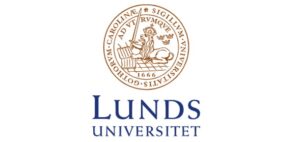
15 Postdoctoral Fellowships at Lund University, Sweden
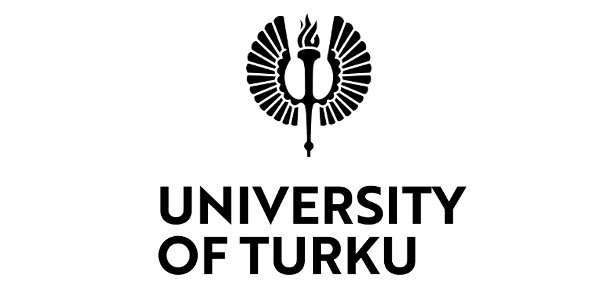

06 Fully Funded PhD Programs at University of Turku, Finland

12 Postdoctoral Fellowships at Tulane University, Louisiana
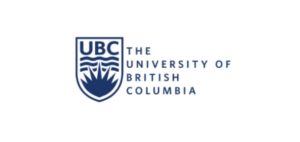
18 Postdoctoral Fellowships at University of British Columbia, Canada
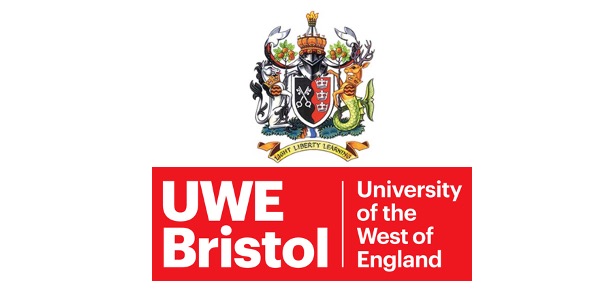
18 Fully Funded PhD Programs at University of the West of England, England
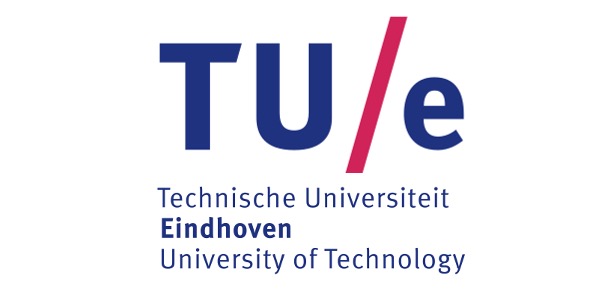
27 Fully Funded PhD Programs at Eindhoven University of Technology, Netherlands

13 Postdoctoral Fellowships at Tulane University, Louisiana
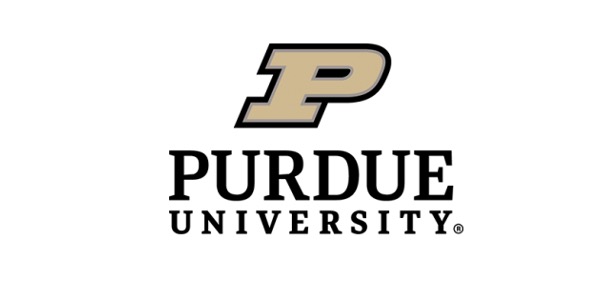
30 Postdoctoral Fellowships at Purdue University, Indiana

45 Postdoctoral Fellowships at University of Michigan, Michigan
Leave a reply cancel reply.
Save my name, email, and website in this browser for the next time I comment.

Get Job-ready Professional Certificates for in-demand Careers
Log In to Resume Trick
- Log in with Google
Forgot password?
Don’t have an account? Sign Up here
Create your free account
Please verify email. check your inbox and follow the activation link., recover your password.
Please enter your email to reset your password. You will receive letter with the password reset link.
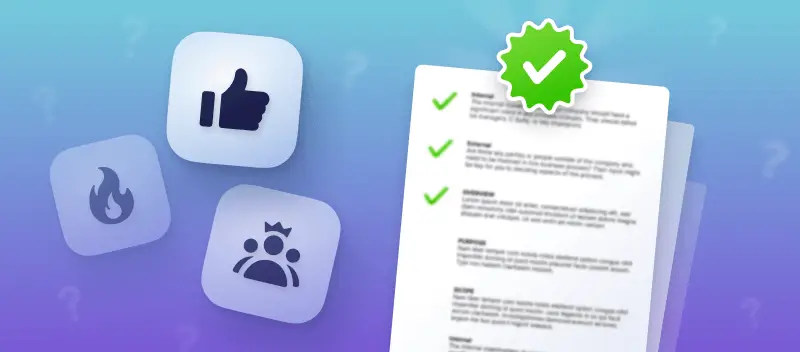
How to Write a Successful Motivational Letter
- Jan 25, 2024
- 4,367 views
As you look for a new opportunity, be it seeking a job or applying for school , you may need to write a motivational letter.
Composing inspirational letters requires creativity, thoughtfulness, and an appreciation of the message one intends to convey. When compiled correctly, it can be an effective way to express yourself and your motivation.
This article offers tips on constructing an outstanding motivation statement. We will discuss what should be included in the letter and how to format it. Additionally, the article will cover what words to use to ensure your letter is as strong and persuasive as possible.
Additionally, we will provide some motivation letter samples so you can get an idea of what works best.
Equipped with this advice, you will be armed to construct a noteworthy motivational statement that will help you reach your aspirations.
Prepare all your application materials
When sending out an application of some kind, you will likely need to submit a package of documents . You may need to complete an online application, provide letters of recommendation , and send a copy of your resume.
To ensure you present yourself in the best light, consider polishing your resume with a free online resume builder!
The builder offers resume templates to help you create a neat and appealing document that presents all your best qualities and expertise.
The AI-powered writing assistant helps come up with the best words to describe you as a professional.
Save time, money, and effort while writing your best resume with Resume Trick .
Create your professional Resume in 10 minutes for FREE

What is a Motivation Letter
A motivation letter is a document that serves to introduce who you are and elucidate your personality. This type of inspirational letter may be used to accompany an application for a job or a college/university program.
The letter of motivation should be written in a professional yet personable tone to show your inspiration to apply for a certain position or a degree. You should also demonstrate your enthusiasm for the opportunity and express what motivated you to apply.
The main goal of the motivation statement is to get the reader to look at your CV or resume .
An effectively written letter of motivation can leave a notable impression on prospective employers or admission counselors. It often can be the deciding factor for the "yes" or "no".
Devote enough time to produce a unique, intriguing letter that will aid you to be noticed among the others!

Motivational Letter vs. Cover Letter
.webp)
Motivational statements and cover letters are documents used in the application process. However, they are different in purpose and content.
The motivation statement must be composed in a friendly, conversational style. It expresses your passion for the opportunity , talks about the talents you have, and how you can help the organization reach its goals.
The cover letter should be professional and concise. It must be well-structured and provide a clear summary of your credentials and skills. It has to be direct and to the point, highlighting relevant experience and qualifications.
Despite the differences, you can try using our cover letter templates for formatting and organizing your motivational letter.
In conclusion, a letter of motivation and a cover letter are two distinct documents. While the two are both important, they serve different purposes and must be written differently.
Ensure that you select the correct type of letter based on the requirements and compose effective supporting materials for your application.
When to Use a Motivational Letter
Crafting a motivational letter may be needed to aid you in being noticed . Here are some occasions when you may need to compose a motivational statement.
A well-written motivational letter serves as a great tool for setting yourself apart from other contenders and exhibiting your keenness for the role or opportunity. Make sure to include all relevant information that is needed to make your application successful!
Motivation Letter Examples
An engaging motivational statement can make the difference between being accepted and rejected. Below you will find examples of letters for various purposes . Use them as a reference for crafting your own.
Example of a motivational letter for a university application:
Dear Ms. Campbell, My name is Alex Throssell. I am writing to you to support my application for admission to Jackson State University. I am enthusiastic about obtaining a degree in Computer Science. I am confident that your school will give me the ideal opportunity to realize my goals. I have been interested in the informatics field since I was a child. I have been coding ever since I was 12 years old. I love solving problems and developing new applications. In high school, I completed courses in computer programming and web development, which sparked my interest in software engineering. In college, I plan to continue to explore the world of computer science. I want to learn more about Artificial Intelligence and Machine Learning, two topics that fascinate me. Additionally, I plan to become involved with research projects related to these topics as well as other areas of computer science. I am confident that Jackson State University can provide me with the best education to help me achieve my goals. Not only does it have excellent faculty members and research opportunities, but also offers a stimulating environment where I can grow both academically and personally. Appreciation for your thoughtfulness in reviewing my application. I anticipate your reply! Best regards, Alex T
Examples of a motivation letter for an internship:
Dear Mr. Miller, I am excited to submit my application for the Social Work Intern position at Compassionate Care Services. With a solid academic foundation, I am confident in my ability to contribute meaningfully to your team. Currently pursuing a degree in Social Work at Towson University, I actively engage in projects that enhance my practical knowledge. Notably, I led the "Youth Empowerment Program" at my university, overseeing skill-building workshops, mentorship programs, and career guidance. This experience sharpened my research, collaboration, and leadership skills, further deepening my understanding of the field. Beyond my academic endeavors, my strong customer service skills and effective communication make me a valuable addition to your team. My passion for Social Work drives my commitment to community betterment. I am eager to apply my skills to contribute to the mission of Compassionate Care Services. Thank you for considering my application. I am enthusiastic about the opportunity to discuss how my background, skills, and dedication align with the goals of your organization. Please feel free to contact me for any additional information. Sincerely, Elizabeth Tucker
A motivation letter example for a job application:
Dear Mr. Watts, I am writing to apply for the Landscape Architect role at EcoDesign Studios. I have 5 years of experience in the field. I am confident that I possess the necessary skills and qualifications to make an immediate impact on your team. I am passionate about architecture and have worked hard to develop a deep understanding of the industry. At my previous company, I led the "Urban Harmony Plaza" project, transforming an underutilized urban space into a vibrant, green hub. Collaborating closely with local stakeholders, I applied my architectural skills to address real-world challenges, highlighting the importance of sustainable practices in enhancing community well-being. I am highly motivated and eager to contribute to the success of the EcoDesign Studios. I have a proven track record of meeting deadlines, exceeding expectations, and delivering high-quality results. I am also highly organized and take pride in ensuring that projects are completed according to set deadlines and standards. Furthermore, I have excellent interpersonal skills and enjoy working as part of a team. I am comfortable working with people from diverse backgrounds and cultures and collaborating seamlessly with colleagues at all levels. I would be delighted to put my skills and experience to work for your organization. I believe my qualifications render me a perfect fit for the role and would welcome the opportunity to discuss this further in an interview. Thank you for considering my application. Sincerely, Matthew M. Ferrell
A motivational letter example for joining an organization:
Dear Ms. Ruben, I am thrilled to express my fervent interest in joining Community Empowerment Hub, captivated by its commitment to fostering social and economic justice. The impactful strides your team has taken in improving lives resonate deeply with my personal mission. For quite some time, I have closely followed and been inspired by your organization's dedication to ensuring universal access to quality education, healthcare, housing, and other fundamental needs. I firmly believe in the transformative power of collective action to institute enduring change. My educational background, including a degree in political science, coupled with my experience in the public sector, positions me well for this role. Through my involvement in a recent legislative initiative on climate change, I honed my understanding of policy issues and effective strategies for driving social change. My passion lies in utilizing my skills to contribute to a better world, and I am enthusiastic about the prospect of bringing my expertise to your team. Eager to contribute meaningfully, I am confident in my ability to aid your organization in advancing its goals and objectives. Thank you for considering my application to join Community Empowerment Hub. I am eager to delve deeper into how I can actively contribute to your mission and make a lasting impact on the world. Sincerely, Paul Brown
A motivation letter sample for funding application:
Dear selection committee, I am writing to seek funding for my project, "SustainVisions," which aims to produce a series of educational videos promoting sustainability in our community. The "SustainVisions" project will showcase individuals from our community who are passionate about sustainability, highlighting their impactful work. These videos will be strategically shared on various social media platforms, with the overarching goal of inspiring viewers to take positive actions towards a more sustainable lifestyle. The requested funding will be allocated to cover essential aspects such as equipment, production costs, and associated travel expenses. With this support, I envision creating a unique video series that not only educates our community but also has the potential to resonate beyond our local borders. This endeavor is crucial in raising awareness about sustainable practices and encouraging tangible actions that can positively impact our environment and the lives of many. Beyond my passion for this cause, my experience demonstrates a proven ability to execute impactful projects. I have collaborated with non-profits, government agencies, foundations, and various organizations to develop sustainable initiatives with lasting effects. My skill set includes conducting thorough research, designing effective programs, and establishing valuable relationships with key stakeholders. I am committed to ensuring that any funding received will be utilized efficiently, meeting deadlines, and staying within budget while delivering top-tier results. With a track record of successful projects, I am confident that "SustainVisions" can make a tangible difference with your support. I sincerely believe in the merit of this project and hope for your consideration and support. Thank you for your time and thoughtful consideration. All the best, Nichole Fisher
How to Format a Motivational Letter
The formatting of the motivation statement has to be concise but appealing. Although the requirements are less strict as compared to the cover letter writing , it is a professional document, not a note to a friend.
Tips for formatting your motivation letter:
- Use a readable font, such as Arial or Times New Roman, in size 11 or 12.
- Leave 1-inch margins on all four sides of the page.
- Begin by writing your name and address on the initial line.
- Include the date underneath your address.
- List the recipient's contact information below the date.
- Use a polite salutation, such as "Dear Mr./Ms./Dr." followed by their last name.
- Ensure that each paragraph is no more than five lines long. Each sentence should contain no more than 12 words.
- End with a polite closing such as "Sincerely" and include your name underneath.
- Include any relevant documents, such as a resume or references, after your signature.
By following these simple steps, you can guarantee that your motivational statement has the right format and appears professional.
How to Structure a Motivational Letter
.webp)
Drafting such a letter can help you make a good first impression . So, it's worth investing time into crafting a well-written document that outlines your skills, qualifications, and suitability for the role.
Your motivational letter ought to be brief and limited to one page . It has to include the following: an introduction, body paragraphs, a conclusion, and your information.
In the beginning, you should articulate your interest in the role and how it complements your career plans. The body paragraphs should explain why you are qualified for the job by showcasing your qualifications and exhibiting your enthusiasm about the opportunity.
The conclusion is that you can share your excitement for the role and thank them for taking the time to look at your application. At the end of your motivation letter, be sure to include contact information . This will ensure you can be reached out if there are any questions or for further discussion of your candidacy.
Make sure your motivational letter is tailored to the job and reflects your enthusiasm, then send it off with confidence!
Tips on how to Write a Motivation Letter
Motivational letters are a necessary component of competition. It helps companies or schools make decisions about who to choose and shows them what kind of person you are.
Developing a compelling motivation letter can assist you in surpassing other applicants and displaying your devotion to the role or program.
Follow the below steps to create an impressive letter of motivation that will leave a good impression on potential employers or admissions boards.
Motivational letter writing tips:
- Prepare for writing. Think about what you want to say and why you are writing it. Ensure that you are prepared to explain your interest in the letter.
- Start with a captivating introduction. [Introduce yourself](/blog/tell-me-about-yourself.html, your goals, and your reason for applying.
- Use compelling language. Be clear and concise so your motivational statement is easy to read and understand. Keep your sentences short and to the point.
- Demonstrate your enthusiasm. Tell about your passion for the position, the program, or the project you are applying for.
- Describe your goals and objectives . Explain what you hope to gain from this opportunity and how it fits into your long-term goals.
- Show your commitment. Speak about how you will contribute to the company/university and its mission.
- End your letter with an emphatic declaration. Illustrate your eagerness for the discussed matter and express gratitude for the reader's consideration.
- Proofread and edit carefully. Ensure that there are no grammar, spelling, or formatting errors in your motivational letter before sending it.
By abiding by the above instructions, you will be able to compose an impassioned motivation letter which will give you a head start on attaining the job or getting into the university.
Dos and Don’ts
It is important to remember that success comes from within . Here are some dos and don'ts to keep in mind when it comes to creating a motivation statement:
- Write clearly and concisely.
- Make sure your letter is tailored to the specific job or program you are applying for.
- Use powerful language that exudes confidence.
- Incorporate relevant examples or reasons behind your motivation.
- Highlight any special aspects that make your application unique.
- Don't copy and paste from other letters or applications.
- Don't use weak phrases like "I think" or "I believe". Instead, use stronger words like "I am confident".
- Don't be too general with your statements. Be specific about what you can bring to the table.
- Don't leave out any important details. There should not be questions left for the reader.
Writing a motivational letter: conclusion
Constructing a letter of motivation can be laborious. Yet, it does not have to. Follow the provided guidelines and the motivation statement examples to build yours.
Key takeaways:
- It is essential to be clear and concise in your writing, as well as to make use of effective language.
- Highlight your enthusiasm and illustrate why you are the most suitable person for the opportunity.
- Ensure that the letter is adapted to the specific employer or school you are applying for.
- Demonstrate your passion and devotion.
- Proofread and edit your letter for any errors.
- Don't forget to include a professional signature at the end.
Now, send your letter and wait for a response. Remember: be patient, confident, and positive! Good luck with your application!

Aiden Anderson
Resume Trick Staff Writer
Aiden Anderson is a Resume Trick staff writer specializing in job search-related topics, including resume and cover letter writing. Aiden is constantly seeking innovative ways to bridge the gap between technology and career development. His goal is to offer valuable insights to job seekers on leveraging digital tools for a successful job search. Aiden's passion for the internet and technology is also reflected in his articles for Video Candy .
Rate this article:
Like the article spread the word, related articles.
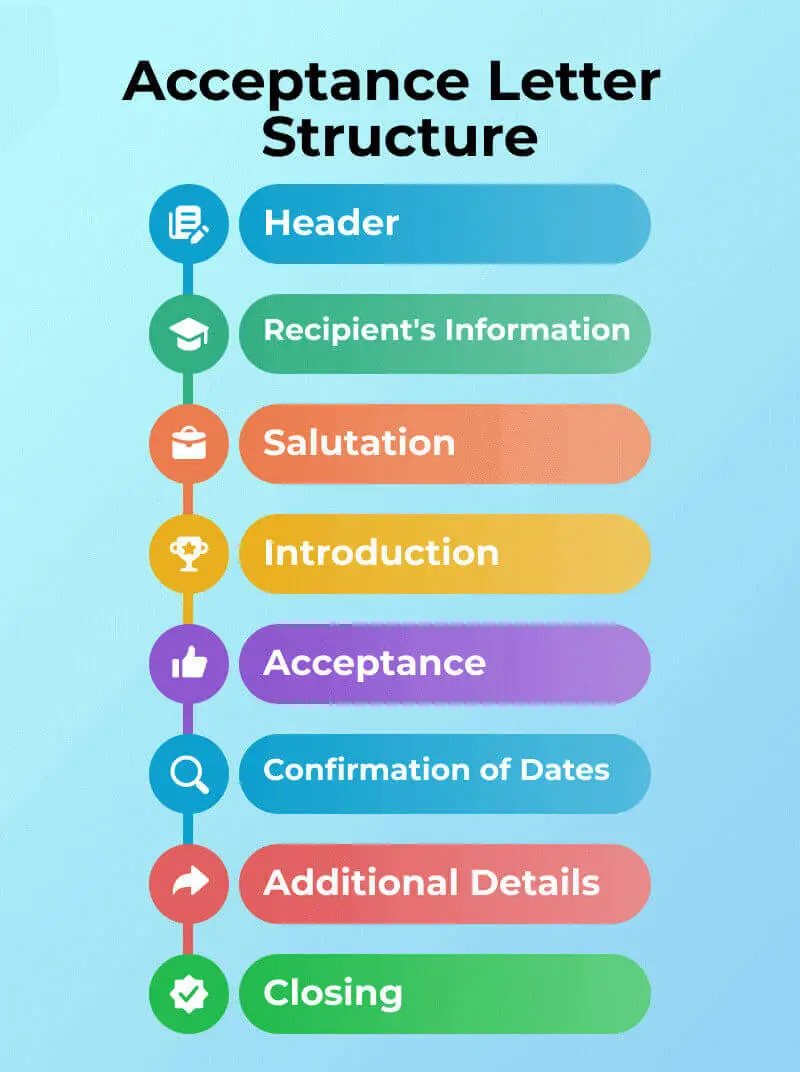
How to Accept a Job Offer with Examples for 2024
Congratulations! After the interview, you have been offered a job and now it's time to make a ...

One-Page Resume Guide and Examples for 2024
Employers often sift through numerous applications, seeking candidates who stand out amidst the ...

How to Write a Letter of Resignation in 2024
Changing jobs involves not only an exciting part of accepting the new position but also leaving ...
- Resume Writing
- Resume Examples
- Cover Letter
- Remote Work
- Famous Resumes
- Try Kickresume
How to Write a Cover Letter for an Internship? (+5 Real Internship Cover Letter Examples)
- Julia Mlcuchova ,
- Updated March 20, 2024 8 min read
Trying to figure out how to write a cover letter for an internship ? Look no further!
POV: After weeks and weeks of searching for the right internship opportunity, you've finally found it. But, at the end of the posting, there's a single short sentence that takes you aback: “Please, attach a cover letter to your application .”
Although some consider cover letter writing to be a relic of the past, it still holds its rightful place in the professional world.
Because a well-written and persuasive cover letter can sometimes make up for the lack of work experience on your resume . And if you're trying to apply for an internship , this is probably your case, too.
So, continue reading this article and learn:
- What is a cover letter for an internship;
- Whether you need to attach a cover letter to your internship application;
- How to write one in 7 steps;
- 5 real-life internship cover letter examples .
Table of Contents
Click on a section to skip
What is a cover letter for an internship?
Do you need a cover letter for an internship, how to write a cover letter for an internship in 7 steps, 5 real-life internship cover letter examples, key takeaways: how to write a cover letter for an internship.
Generally speaking, an internship cover letter is a formal document that accompanies your resume when applying for an internship.
When it comes to its content, a cover letter for an internship falls somewhere between a traditional cover letter and a motivational letter .
- A traditional cover letter , used by job applicants with years of experience, is supposed to underline some of the candidate's most relevant and impressive skills, qualifications, and work achievements .
- A motivational letter , used mostly in academia, aims to communicate one's passion for the subject, their motivation, and personal goals .
Hence, a cover letter for an internship combines the purpose of the traditional cover letter (convincing the recruiters that you're the right person for the job) with the tone and strategy of the motivational letter (writing about personal motivations and goals).
A truly successful internship cover letter should answer the following questions:
- Who are you?
- Why are you interested in this particular internship?
- Why are you the best fit for this internship?
- What do you want to gain from this internship?
Absolutely!
In fact, you should always attach a cover letter to your internship application , even if it isn't explicitly required from you.
Why, you ask?
Well, consider this: Internships are crucial stepping stones towards your dream career. And they're also incredibly competitive. A single internship opening can be answered by tens of applicants at a time.
But how can you stand out from a crowd of equally inexperienced candidates? Certainly not by your non-existent professional accomplishments, right?
When companies look for interns, they don't expect you to have a ton of real-life experience. They aren't looking for a “finished product,” but for someone with a genuine desire to learn and enthusiasm for the job.
And these two are your weapons of choice!
How can a cover letter for an internship help you?
Apart from the reasons mentioned above, your internship cover letter is also responsible for:
- Conveying first impression. Usually, recruiters will read your cover letter before looking at your resume. So, it's the perfect opportunity to introduce yourself to them in a memorable way.
- Showing your efforts. Next, taking the time to craft a thoughtful cover letter shows that you're willing to put in that extra effort to stand out from the rest of the candidates.
- Highlighting your communication skills. Also, a well-written cover letter demonstrates your ability to articulate your thoughts clearly and professionally.
- Showing your professionalism. When you walk into a room, it's polite to introduce yourself and shake everybody's hand. This is exactly what a cover letter does! To attach one to your application is a common courtesy.
Now that you're familiar with the whats and whys , let's have a look at how to write a good cover letter for an internship step-by-step.
For example : Application for [name of the internship] internship – Surname.
Then, place your contact information (your name; professional email address; phone number; link to your website / portfolio / social media accounts if relevant) directly into the header .
If you know the recipient's name, address them by “ Dear [full name] ,” or “ Dear Mrs/Mr [last name] ,”. If you don't know who to address the cover letter to , address it more generally to “Dear Hiring Manager,” .
In the first paragraph of your cover letter , start by stating your name and where you studied (including your current degree and year of study). Proceed by explaining how you came to know about the internship and what are your motivations for applying to it.
Since you don't have much work experience, you can talk about your academic achievements; relevant coursework; dissertation project; extracurricular activities; volunteering; membership in relevant societies, etc.
The closing paragraph of your cover letter should reiterate your desire to get the specific internship, express gratitude to the recipient for their time and consideration, and include a final call for action (i.e. "I look forward to discussing the next steps during an interview." )
Finally, based on how you greeted the recipient of your cover letter, you can sign off with either “ Yours sincerely ,” or “ Yours faithfully ,” . If you addressed the recruiter by their name, sign off with the former; if not, use the latter.
Don't feel like writing your internship cover letter by hand?
Let our AI cover letter writer create the first draft of your internship cover letter!
Undoubtedly, the best way to learn something is to look at specific examples . And that's exactly what we're going to do right now!
Below, we've prepared 5 internship cover letters written by real people with the help of our cover letter templates .
And, each of them is accompanied by our internship cover letter writing tips that you can implement into your own cover letter!
FYI, you can use each of these examples as the first draft for your very own internship cover letter – simply click on the red button and start personalising the text (or let AI handle it).
#1 Philips Marketing Intern Cover Letter Sample
Internship cover letter example:.
This cover letter sample was provided by a real person who got hired with Kickresume’s help.
What can you take away?
- Eye-catching header. Firstly, the header is visually clearly separated from the rest of the text. This makes the recruiters notice it immediately. Plus, the contact information of the company is also featured in the left-hand corner - just like it would be on an actual letter.
- Research the company before applying. Notice sentences like: “ I really like and relate to what Philips stands for … ” and “ Furthermore, it is very appealing that Philips operates on an international level… ”.This shows that the candidate’s done a thorough research of the company's philosophy and structure.
#2 Warner Bros. Public Relations Intern Cover Letter Example
- Share a personal story. This can help you establish a sentimental connection between you and the company. Show them that for you, working for their company means more than any old internship.
- Name-drop a referral. Now, this is a little bit of a cheat code. But, if you happen to know about anyone who has worked/currently works for the company, slip their name into your cover letter.
#3 University of Massachusetts Boston Intern Cover Letter Example
What can you take away .
- Write about what you want to gain from the internship. It shows that you're not there just to have something to put on your resume; but that you’re motivated by the idea of gaining actual industry knowledge and skills.
#4 Audit/Tax Summer Internship at CohnReznick Cover Letter Sample
- Mention any relevant academic activities. If you're wondering how to write a cover letter for an internship with no experience whatsoever, this is your way to go! For example, notice how this candidate noted all of his relevant courses, skills, association membership, and competition participation.
- Focus on transferrable skills. Especially when your study programme doesn't necessarily fit the internship opening to a T. Instead, focus on any transferable skills you've picked up.
#5 Intern at NBC Cover Letter Sample
- Keep your opening and closing paragraphs short and sweet. As you can see in this example, it helps keep a certain visual harmony of the overall document. And, despite the length, both paragraphs do exactly what they're supposed to. Besides, recruiters might be discouraged to read the rest of your cover letter if your introductory paragraph is too long.
To sum it all up, an internship cover letter is a formal document that you submit together with your resume when applying for an internship. Its content should be something between a traditional cover letter and a motivational letter.
Its purpose is to introduce yourself to the recruiters in a more personal way than the resume allows.
The main things you want your internship cover letter to communicate are:
- who you are,
- why you're interested in this opportunity,
- what make you the best fit for the internship,
- your motivation (your long-term professional goals),
- your desire to learn (what you want to gain from the experience).
To write a truly impactful and persuasive cover letter, we recommend following these 7 key steps:
- Specify which internship you're applying for in the subject line.
- Include your contact information in a header.
- Address the recipient appropriately.
- Introduce yourself & your motivations in the opening paragraph.
- Elaborate on why you're a good fit and what motivated you in body.
- End your cover letter with a confident closing paragraph.
- Finish off with a polite sign off.
Finally, if you feel that the examples provided in this article aren't enough, you can always find more in our cover letter database .
Julia has recently joined Kickresume as a career writer. From helping people with their English to get admitted to the uni of their dreams to advising them on how to succeed in the job market. It would seem that her career is on a steadfast trajectory. Julia holds a degree in Anglophone studies from Metropolitan University in Prague, where she also resides. Apart from creative writing and languages, she takes a keen interest in literature and theatre.
Related Posts
How to address a cover letter without a name use these 5 salutations, motivation letter vs cover letter: what are the key differences (+examples), share this article, join our newsletter.
Every month, we’ll send you resume advice, job search tips, career hacks and more in pithy, bite-sized chunks. Sounds good?

The Difference Between a Cover Letter and a Letter of Interest
According to Zety , a service that creates professional communication templates, you use a cover letter to accompany your resume when you’re applying to a specific job, and use a letter of interest to put yourself forward for a job that isn’t advertised. Essentially, you’re pitching yourself to a company of interest, telling them your qualifications, and hoping they’ll identify a spot for you instead of waiting around for them to post an opening that aligns with your skills and experience.
Letters of interest are also helpful when someone has tipped you off to an opening that hasn’t yet been made public, according to Indeed . The goal is to introduce yourself to hiring managers and get your talents on their radar, even if it means they only keep you in mind for future opportunities.
A cover letter is reserved for when a specific job is available, so it might get you more immediate results. A letter of interest, on the other hand, could take months for results—but will help those in charge of hiring find a job that’s just right for you, should one become available.
What to include in a letter of interest
Your letter of interest should be full of background information highlighting why you’d be a great fit for the company. Unlike with cover letters, you won’t have a clear job posting or description of what the company wants right now, so you should first research the organization and identify what they do well, what they could use help with, and how your specific talents fit in somewhere. During your research, be sure to identify the most likely hiring manager, recruiter, or the manager of the team you want to be on, and address the letter to them.
Introduce yourself briefly by sharing your name and a one- or two-sentence description of your background. Then explain why you’re writing to that specific company. Share specific things about the organization that appeal to you, and then explain how you fit into what you described, sharing your experience, skills, training, and interests. If your research turned up anything about the company culture, describe how you’ll fit in and what benefits you’ll add. Finally, end your letter with a request for an informal interview. Having a chat with the hiring managers or recruiters will help them get to know you and better ensure you stick in their memory in case a job opens up in the future.
Like a cover letter, it shouldn’t exceed one page and should include your contact details. Also like a cover letter, you should try to make it as specific to the company as possible and not use a boilerplate template. In fact, in this instance, you should be even more specific about your interest in the company. Make sure you point out the details about the organization that interest and excite you, so they know you did your research.
Sign up for Lifehacker's Newsletter. For the latest news, Facebook , Twitter and Instagram .
Click here to read the full article.

What is a Letter of Intent? How to Write One for a Job [+ Examples]
Published: March 14, 2024
Standard job applications have a standard set of practices. You turn in a resume and cover letter, and then, if selected, you move through a few rounds of interviews and get the job.

However, not all potential job opportunities start with an application. In fact, many begin with initiative from a job seeker.

Those job seekers will send in a letter of intent rather than a cover letter . In this article, we’ll take a look at what a letter of intent is and highlight some strategies for writing the best LOI you can. We’ve even included a template to help you get started.
Here’s what you’ll find:
What is a letter of intent?
Letter of intent vs. cover letter, letter of intent vs. letter of interest, when to use a letter of intent.
How to Write a Letter of Intent for a Job
Letter of Intent Samples
Letter of intent template.
A letter of intent is a less common way of expressing interest in a company. It targets reasons you’re looking for opportunities with a specific organization.
A letter of intent does include elements of a traditional cover letter, such as relevant experience and skills, but it’s used in slightly different contexts. LOIs emphasize alignment between a job seeker and an organization.
.webp?width=650&height=731&name=image1%20(4).webp)
There are a few key differences between a cover letter and a letter of intent, including:
Context. While a cover letter responds to a specific job listing, a letter of intent targets an organization more generally. It may or may not have a specific job opening at the time that the LOI is sent in.
Focus. A cover letter explains why an applicant is a good fit for a specific role . An LOI, on the other hand, addresses an individual’s compatibility with an overall organization or more general role.
Initiative. A cover letter is a reactive document responding to a job opening. A letter of intent, however, demonstrates more initiative and provides information before an organization specifically requests it.

22 Job Seeking Templates
Download this bundle of 22 expertly-crafted templates for cover letters, resignation notices, and resumes.
- Resignation Letter Templates
- Cover Letter Templates
- Resume Templates
You're all set!
Click this link to access this resource at any time.
Letter of intent and letter of interest are often used interchangeably. While there are a lot of similarities between the two documents, there are also a few key differences:
Level of intent. Letters of intent have a high level of intentionality, while letters of interest are more exploratory. A letter of intent proposes action, while letters of interest are for information gathering.
Commitment level. A letter of intent is a high-commitment way of expressing interest in a company, while a letter of interest is a lower commitment. An individual is more likely to send out multiple letters of interest.
Action orientation. A letter of intent always ends with a call to action, while a letter of interest is more laid-back and may not request anything specific from the recipient.
While both letters demonstrate initiative and are closely tailored to the company, they do serve slightly different purposes.
There are lots of scenarios where a job seeker may want to send out a letter of intent. Here are a few examples:
You have a high level of interest in a specific company, but there’s not an open role.
You are interested in networking with a company in a committed way.
You want to reach out with a formal follow-up after a networking event.
You’re applying to a highly competitive field.
You’re aware of a potential job opportunity with an organization that hasn’t been published yet.
Additionally, students or job seekers switching industries may use letters of intent to apply to educational opportunities like internships and apprenticeships — though those may also be called cover letters .

How to Write a Letter of Intent
There are plenty of ways to approach writing a letter of intent for a job. Here’s a step-by-step process for writing your LOI draft:
1. Provide your contact information.
At the top of your LOI, you’ll want to provide contact information so your recipient can contact you about future opportunities. This can include your phone number, email, and address.
2. Use an appropriate greeting.
For some opportunities, a formal greeting is appropriate. In other situations, a more informal approach may be ideal. If possible, address the specific recipient.
3. Provide an introduction.
In the intro paragraphs, you’ll want to tap into three specifics:
Who you are.
Why you’re reaching out.
How you got this company’s information.
Feel free to vary the order of this information. Your LOI intro may be formal or more playful, depending on who you are and the organization you’re submitting to.
4. Dive into your strengths and company alignment.
An LOI is created to clearly convey why you’re a good fit for the organization. In the body paragraphs of your letter, you’ll want to explain:
- Your strengths.
- What you do.
- How those things would fit with the organization.
5. Guide the conversation into the future.
All LOIs end with a call to action, which is one of the things that differentiates it from a letter of interest or a cover letter. Map out potential next steps so it’s easy for the reader to take action. It could include:
A request to schedule a meeting.
Making a specific pitch.
Encouraging the recipient to send a follow-up email.
6. Write a thoughtful conclusion .
Conclude your LOI by reiterating your interest in the company. Make sure to thank the recipient for their time, too — there wasn’t a job opening request, so they took time out of their day to read your letter.
If you’re sending your LOI because of an internal referral, be sure to reference them within the letter.

Let’s go through a few different samples of LOIs and highlight what each does well. Refer to these samples as you draft your own letter of intent for guidance on incorporating the elements of an LOI seamlessly.
Internal Connection

In this letter of intent, Jennifer leverages an internal connection. This is a great way to earn a few extra points when explaining how you know about the business. Beyond that, Jennifer’s experiences align well with the work that the wine bar does.
What I like: This letter of intent does a great job of personalization, weaving through the internal connection perfectly in a few different spots. A referral is a powerful aid to incorporate into an LOI, and Jennifer did a great job dropping hints of her connection.
Making a Pitch
.webp?width=650&height=651&name=image4%20(1).webp)
What I like: In this letter, Mark is making a pitch. He still covers the bases of a great LOI — discussing his strengths and alignment with the brand. But instead of just calling for a meeting, he makes a pitch that is specific to the organization. This provides value to the recipient and makes Mark look like a strong collaborator.
Mark could benefit from HubSpot’s CMS Hub to manage his pitches. Lead generation and content creation are important parts of freelancing, and Mark needs to stay organized in order to do it well. Learn more about HubSpot’s CMS Hub here .
Diving Into Alignment
.webp?width=650&height=819&name=image7%20(1).webp)
Letters of intent are standard documents, so you don’t need to worry about reinventing the wheel each time you send one. Use this template as a resource to ensure your letter includes all the important parts.
[Your name]
[Your contact information]
[Recipient’s Name]
[Recipient’s contact information]
Dear [Recipient or To Whom It May Concern] ,
My name is [Your Name] , [title/relevant information about yourself] , and I heard about your organization through [how you know the organization] . I’m reaching out to connect. I would love to chat if your team plans on expanding.
I have skills in [skills] that I believe would be a great fit for your organization. Your values of [company values] are in close alignment with my strengths, and I believe I could make a great contribution.
I believe that my [abilities/skills/interests] would benefit your company, and I’d love to talk more about any potential opportunities that arise with [name of organization] . If interested, please reach out by [phone/email] to schedule a time to meet with me.
Thank you for taking the time to read my letter, and I hope to talk with you further in the future.
Of course, you’ll want to edit the template for tone and specifics related to yourself and the organization you’re contacting.
Finding Success With a Great Letter of Intent
Sending a letter of intent can be vulnerable, but it’s a great way to make new connections and set yourself up for employment success.
Refer to these strategies, samples, and templates to make sure your LOI is going to be the most effective letter possible. Emphasize your alignment with the organization, and you’re sure to see success!
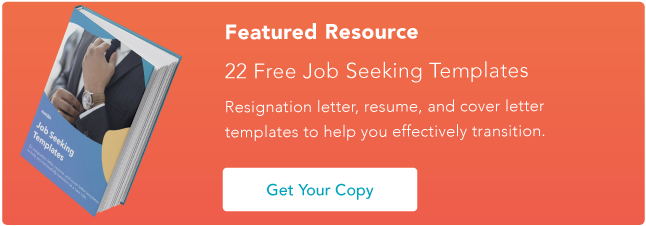
Don't forget to share this post!
Related articles.
![motivation letter is cover letter The Best 30-60-90 Day Plan for Your New Job [Template + Example]](https://blog.hubspot.com/hubfs/Untitled%20design%20%2859%29.jpg)
The Best 30-60-90 Day Plan for Your New Job [Template + Example]
![motivation letter is cover letter How to Write a Respectable Resignation Letter [+Samples & Templates]](https://blog.hubspot.com/hubfs/resignation-letter-template.webp)
How to Write a Respectable Resignation Letter [+Samples & Templates]

12 Incredible Answers to "What Is Your Greatest Weakness?" — That Aren't "Perfectionism"

20 Creative Interview Questions (With Sample Answers)

The Best Fonts for Your Resume in 2023, According to HubSpot Recruiters

26 Quotes to Inspire Your Job Search

The Job Search Process: 10 Tips on How to Land Your Dream Job (+3 Resume Examples)

Instagram and TikTok Resumes: Are Marketing Managers Watching Them?
![motivation letter is cover letter The Great Resignation: How It's Changing Hiring for Companies and Job Prospects [+ Expert Insight]](https://blog.hubspot.com/hubfs/great-restructuring.jpg)
The Great Resignation: How It's Changing Hiring for Companies and Job Prospects [+ Expert Insight]

10 Essential Job Search Strategies to Help Land Your Next Big Gig
22 resignation letter, resume, and cover letter templates.
Marketing software that helps you drive revenue, save time and resources, and measure and optimize your investments — all on one easy-to-use platform

Home Career Advice Blog
Innovative Cover Letter Strategies for 2024

The importance of leveraging innovative cover letter strategies can't be overstated. With the job market evolving rapidly, technology continuing to reshape recruitment processes, and competition growing fiercer by the day, students and professionals must adapt their approaches to cover letter writing to remain relevant and impactful.
Below, you'll find various inventive techniques for approaching cover letters that will effectively showcase your skills, experiences, and unique value propositions to prospective employers.
Understanding ATS
First, it’s important to understand what Applicant Tracking Systems (ATS) are and how they’re used. The main goal of ATS is to streamline recruitment by scanning resumes and cover letters for relevant keywords and qualifications. So, to optimize your application’s chances getting noticed, you need to tailor your cover letter to align with ATS requirements. That involves incorporating industry-specific terms and highlighting relevant skills and experiences.
It’s also important to proper format your cover letters and make their content as clear as possible, which will improve readability for ATS (and for hiring managers). So, opt for a clean, easy-to-read layout that makes your content stand out. Use a standard font style and size, such as Arial or Times New Roman, to ensure readability across different devices and platforms. Next, maintain consistent formatting throughout your cover letter, including margins, spacing, and alignment. You can also use bullet points to highlight key achievements or qualifications for quick reference.
Personalizing and Customizing
Personalizing and customizing your cover letters significantly enhance your job application. Just like you would tailor your resume to fit a specific job description, your cover letter should also be customized for each application. One way to do this is to address hiring managers by name and reference specific details about the company or the job position. This demonstrates your genuine interest and attention to detail. Also, consider mentioning recent company achievements, projects, or values that resonate with you. In addition, provide concrete examples, showcasing how your skills and experiences align with the job requirements. Finally, make sure to express your enthusiasm for this specific role.
Storytelling
Embracing a storytelling approach in your cover letter can elevate your job application to new heights. By weaving a narrative that showcases your professional journey and accomplishments, you engage hiring managers on a deeper level. Sharing anecdotes that highlight your skills, challenges, and significant achievements ill attract their attention and create a memorable impression.
Storytelling also allows you to compellingly convey your passion and enthusiasm for the role. And crafting a narrative-driven cover letter makes you more relatable and demonstrates your communication skills. Finally, sharing stories about your experiences can provide talking points for a successful future interview , helping you articulate your qualifications more effectively.
Highlighting Achievements
Effectively showcasing your achievements and accomplishments in your cover letter can significantly boost your chances of landing the job. Highlighting quantifiable accomplishments demonstrates your tangible contributions and value to potential employers. So, strive to include specific examples and metrics to illustrate the impact of your work, such as increasing sales revenue by a certain percentage or completing projects ahead of schedule. Emphasizing your successful track record will capture hiring managers' attention and differentiate yourself from other candidates. Moreover, showcasing your achievements reinforces your credibility and suitability for the role.
Adding Multimedia Elements
Exploring the integration of multimedia elements into your cover letter can provide a unique edge in today's competitive job market. For example, consider incorporating links to your online portfolio or online videos that showcase your skills or achievements. However, you must ensure compatibility and professionalism when multimedia is included in your application. So, opt for formats that are widely accessible and easily viewed across different devices and platforms.
Demonstrating Industry Knowledge
Demonstrating industry knowledge in your cover letter is a great way to show potential employers that you’re informed and engaged. So, stay up to date on the latest trends, developments, and challenges in your field by regularly reading industry publications and following relevant blogs or forums. If it makes sense to, you might include specific examples of industry insights or trends in your cover letter, showcasing your understanding of the industry or role. You might also want to highlight any relevant certifications, courses, or workshops you've completed to demonstrate your commitment to staying informed. Finally, you could discuss how your knowledge can benefit the company, whether it’s by offering innovative solutions or adapting quickly to industry changes.
Aurora Nightly is an accomplished HR manager and hiring specialist with over a decade of experience in talent acquisition. She currently works for Here & Now Movers Maryland . This moving company is dedicated to helping people relocate smoothly by providing excellent moving, packing, junk removal, labor only, and even storage services. With a keen eye for identifying top-tier candidates and a passion for fostering inclusive workplaces, Aurora has been instrumental in shaping the recruitment strategies of this moving company.
Recommended Articles

Want to be found by top employers? Upload Your Resume
Join Gold to Unlock Company Reviews
Vault partners with thousands of colleges, universities and academic institutions to provide students with FREE access to our premium content. To determine if your school is a partner, please enter your school email address below.
Forgot Password?
Enter the email address associated with your account, and we will email you instructions for re-setting your password.
Need more help? Contact Customer Service at [email protected]
Create Account
- Accounting
- Advertising and Marketing
- Aerospace
- Agriculture
- Airlines
- Alternative Energy
- Alternative Health Care
- Animation
- Architecture
- Automotives Manufacturing
- Biology and Life Sciences
- Book Publishing
- Business Administration and Management
- Casinos and Casino Hotels
- Chemicals
- Chemistry
- Child Care
- Comic Books and Graphic Novels
- Commercial Banking and Financial Services
- Computer and Video Game Design
- Computer Hardware
- Computer Software
- Construction
- Consulting
- Cosmetology
- Dance
- Defense
- Dental Care
- Design
- Earth Sciences
- Education
- Elder Care
- Electronics Manufacturing
- Energy
- Engineering
- Entrepreneurship
- Environmental Science and Conservation
- Event Planning
- Facilities Management
- Fashion and Apparel
- Film
- Fire Fighting
- Fitness and Sports Training and Coaching
- Food and Beverage Production
- Foreign Languages and Studies
- Foreign Trade
- Forestry and Forest Products
- General Consumer Products
- Government
- Health Care Management
- Health Care Providers
- Hospitality
- Human Resources
- Import Export
- Information Technology
- Insurance
- Internet Content
- Internet Services and Security
- Investment Management
- Journalism
- Letter and Package Delivery
- Library and Information Services
- Machining and Machinery
- Manufacturing
- Mathematics and Physics
- Media and Entertainment
- Medical Equipment Manufacturing
- Metals
- Military Services
- Mining
- Museums and Cultural Centers
- Music
- Nanotechnology
- Newspapers and Magazines
- Nonprofit Sector
- Nuclear Power
- Oil and Gas
- Packaging
- Parks and Public Lands
- Personal Care
- Pharmaceuticals and Biotechnology
- Photography
- Plastics
- Politics, Public Policy, and Activism
- Printing
- Public Relations
- Public Safety
- Pulp and Paper
- Radio
- Railroads
- Real Estate
- Recording Industry
- Religious Ministries
- Restaurants and Food Services
- Retail
- Rubber
- Sales
- Security and Investigation
- Shipping
- Social Media
- Social Sciences
- Social Services
- Space Exploration
- Sports
- Staffing and Human Resources
- Stone, Concrete, Ceramics, and Glass
- Telecommunications
- Television
- Textiles
- Theater
- Toys and Games
- Travel and Leisure
- Trucking
- Utilities
- Veterinary Medicine and Animal Care
- Visual Arts
- Waste Management
- Wholesale
- Writing and Editing
Trump's inability to pay civil fraud penalty tops for the upmost awkward dilemma | Letters
Trump's learning payback's a ....
I had to Google "petard" to find out what one is but it sure seems as if Donald Trump has just been hoisted by his. Reports are that he cannot secure a bond to cover his civil fraud penalties because underwriters won't accept real estate as collateral and he was turned down by more than 30 companies. I guess that after decades of evaluating his properties depending on which fraud suited his needs no one now is willing to accept his real estate as collateral. The fact that bonds cover penalties resulting from fraudulent valuations makes it even more ironic.
Michael Kirshner, West Palm Beach
More: Could Trump get a third term as President? We have that answer for you. | Opinion
Life would be better under Trump
A reader writes that Donald Trump and Trump Republicans don't want to support Ukraine, the Middle East and the southern border, and he is correct because none of those things would have occurred under Trump's watch. When terrorism reared its ugly head, Trump took out [Iranian Major General] Qasem Soleimani. Under Trump, Vladimir Putin would not be in Ukraine, Houthi rebels would not be attacking ships in the Red Sea. The border would not be wide open, and Hamas would not be attacking Israel. So yes, Trump Republicans are very reluctant to pay for President Biden's mistakes.
Jim Rich, Jupiter
Deal reveals 'Don't say gay' hyperbole
Re the March 13 story, "A settlement has been reached after litigation over Florida's critic-called 'Don't Say Gay' Law," and both sides are claiming victory": Talk about irony. The result is that the law remains as written but the ruling is that the law does not prevent classroom discussion and references to LGBTQ people and associated issues. In other words, after all the disingenuous hoopla, the ruling is that the law doesn't say or imply that teachers are required to "Don't Say Gay." If critics had actually taken the time to read the law in the first place, all the lawsuits and rhetorical hyperbole could have been avoided.
George Bieberbach, North Palm Beach
Patience toward Israeli war wearing thin
The path being charted by [Israeli Prime Minister Benjamin] Netanyahu and his extreme right-wing government is dangerous. Israel continues to reject the two-state solution and insists on controlling the government of its neighbors, by force if need be. How is this any different from the war in Ukraine where Russia wants to control its neighbors? Israel was well aware of the neighborhood when it was given statehood in 1948 when Israel soon began driving out Palestinians from their land. Most were driven into Gaza. Israel needs to accept some responsibility for this Middle East quagmire. The two-state solution proposed by the U.S. appears to be the only way forward for all sides. It’s time for Israel to find a way into that path. The patience of [President Joe] Biden and the American people is growing thin.
Bob O’Donnell, Jupiter
The Palm Beach Post is committed to publishing a diversity of opinions. Please send your views to [email protected] or by mail to Letters to the Editor, The Palm Beach Post, 2751 S, Dixie Highway, West Palm Beach 33405. Letters are subject to editing, must not exceed 200 words and include your name, address and daytime phone number. We only published names and cities with the letters.

IMAGES
COMMENTS
What is a motivation letter? While cover letters are designed for job applications, motivation letters serve a different purpose. Motivation letter is typically used when applying for academic opportunities such as scholarships, internships, or postgraduate programs, but also when applying for a non-profit organization or voluntary work.
Job application: A cover letter is the usual choice when applying for a job, as it emphasises your professional qualifications and demonstrates how you can contribute to a company's success. Academic programme or scholarship application: A motivation letter is typically more appropriate for these situations, as it delves into your passion ...
It's been proven that cover letters help candidates when applying for a position. Between 2017 and 2021, there has been an 18% growth in the importance of including a cover letter with an application. Cover Letter and Motivation Letter Differences in Format. Both cover letters and motivation letters differ a bit when it comes to their format.
Take a new paragraph for every new topic. Remember, your motivation letter aims to convince your recipient of your value, so use compelling facts to be persuasive. 4. Conclude your motivation letter. Write a conclusion to your motivation letter that summarizes your goal and leaves a positive final impression.
Use a professional letter font and set it to 12 pt size. Set your letter spacing to 1" on all sides of the page. Choose a good letter layout to convey your professionalism. Make sure you create a professional letter file title so that recruiters can find your motivation letter right away.
After you write a good opening statement, continue describing your motivations for applying in 2-3 more paragraphs. And consider adding a bulleted list to make your motivation letter easier to read. 3. Close strong. End your letter of motivation with a paragraph that: thanks the reader for going through your letter.
A motivation statement is often longer than a cover letter, allowing you to provide more details about your academic or career journey and aspirations. Although, just like the perfect length of a cover letter, your letter of motivation should also be only one page long. What will change is the word count, which is about 250-400 for a cover ...
The motivational letter shouldn't be confused with a cover letter, the purpose of which is to highlight how specific information on your resume matches a job opening. Think of a cover letter as the introduction to your resume for a hiring manager and your motivational letter as the powerful closing sales pitch for a university or non-profit.
The conclusion of a motivation cover letter is one last chance to sell your attitude, so avoid repeating yourself. When there is so much more than meets the eye, any repetition can make you seem somewhat one-dimensional. Leave one last powerful story for the final sentence and leave the reader wanting to know more.
Date: Write the full date, like "April 6, 2023.". Who you're writing to: Write the person's title, name, and address. Make sure it's all correct. Greeting: Start with "Dear" and the person's name or title, like "Dear Mr. Smith.". Use a colon after. What to say: Split your letter into short parts.
What Is a Motivation Letter? A motivation letter is a one-page document written by those who want to express strong interest in certain roles and positions.In some ways, a letter of motivation is similar to a cover letter since its purpose is to convey an individual's passion and enthusiasm for a specific function or opportunity.. The letter gives individuals a chance to express themselves ...
Why cover letters matter. Research shows 83% of recruiters say cover letters are important to the hiring process! That means you must have a well-written cover letter if you're serious about a job. If writing a cover letter from scratch seems like a hassle, try our Cover Letter Builder.You'll get a completely personalized letter that makes you sound like a pro and showcases your best ...
1. An Example of a Motivation Letter for a University. Let's say you need to write a motivation letter to apply for the University of Environmental Science, EcoSphere. 2. An Example of a Motivation Letter for a Scholarship. A motivation letter example when applying for a scholarship should look similar to this. 3.
1. Write an outline. Writing an outline for your motivational letter can help you to organise the content you want to include. This reduces the chances of leaving out important information. Consider including the following information in your letter: why you want to study the course or volunteer with the programme.
Motivation letter vs cover letter: When to use each of them. The difference between a letter of interest and a cover letter ranges from their definition, their use, and contents. They are essential writings that could warrant a job seeker an opportunity to work with the desired organization. The major difference between a cover letter and a ...
Font - Top 10 best fonts for a letter of motivation are: Arial, Cambria, Calibri, Didot, Garamond, Georgia, Helvetica, Times New Roman, Trebuchet MS, and Veranda. Spacing - The standard letter spacing is 1" on all sides of the page, but you can adjust it accordingly based on the space.
Middle paragraph (s) Closing paragraph. Letter ending and signature. Your cover letter should be one page long and use a simple, professional font, such as Arial or Helvetica, 10 to 12 points in size. Your letter should be left-aligned with single spacing and one-inch margins. Show Transcript.
Header - Input contact information. Greeting the hiring manager. Opening paragraph - Grab the reader's attention with 2-3 of your top achievements. Second paragraph - Explain why you're the perfect candidate for the job. Third paragraph - Explain why you're a good match for the company.
Address your recipient by name, if possible, to give your motivation letter a personal touch. Capture your recipient's attention with the introduction and encourage them to read on, so include details about your achievements in this section. Related: How To Write A Professional Formal Letter. 3. Expand on key topics.
Here's how to nail your motivational cover letter: 1. Start with an Effective Motivation Letter Format. Your letter of motivation is a formal business document and should be treated as such. Here are the formatting rules you need to follow. Address your letter of motivation as you'd address a cover letter. Your contact details go first ...
A cover letter usually accompanies a CV when applying for a job application and helps grab the employer's attention by highlighting why you are the right fit for the job. A motivation letter, on the other hand, is usually used for enrollment at a university, educational program or to be accepted as a volunteer at a non-profit organisation ...
Often than not, candidates are confused between the two such documents - Cover Letter and Motivation Letter. A cover letter is a professional letter given to an employer/recruiter along with a resume or CV. Cover Letters are generally used by companies, employers and recruiters as opposed to motivation letters that are used by university ...
Motivational Letter vs. Cover Letter. Motivational statements and cover letters are documents used in the application process. However, they are different in purpose and content. What is a motivation letter? A motivation letter elaborates on why the candidate is passionate about a job or course. It needs to focus on their goals, skills, and ...
What is a cover letter for an internship? Generally speaking, an internship cover letter is a formal document that accompanies your resume when applying for an internship.. When it comes to its content, a cover letter for an internship falls somewhere between a traditional cover letter and a motivational letter.. A traditional cover letter, used by job applicants with years of experience, is ...
A cover letter is reserved for when a specific job is available, so it might get you more immediate results. A letter of interest, on the other hand, could take months for results—but will help ...
A cover letter explains why an applicant is a good fit for a specific role. An LOI, on the other hand, addresses an individual's compatibility with an overall organization or more general role. Initiative. A cover letter is a reactive document responding to a job opening. A letter of intent, however, demonstrates more initiative and provides ...
The importance of leveraging innovative cover letter strategies can't be overstated. With the job market evolving rapidly, technology continuing to reshape recruitment processes, and competition growing fiercer by the day, students and professionals must adapt their approaches to cover letter writing to remain relevant and impactful.
On the letter's return date, February 23, 2024, your attorney contacted the Committee and requested that Committee staff contact him to discuss the contents of the letter. 11. In that discussion on February 26, 2024, your attorney represented to Committee staff that upon your return from a personal trip, you would produce documents to the
Opinion: These reader letters published March 18-24, 2024, cover school materials and an independent candidate for president.
Please send your views [email protected] or by mail to Letters to the Editor, The Palm Beach Post, 2751 S, Dixie Highway, West Palm Beach 33405. Letters are subject to editing, must not exceed ...